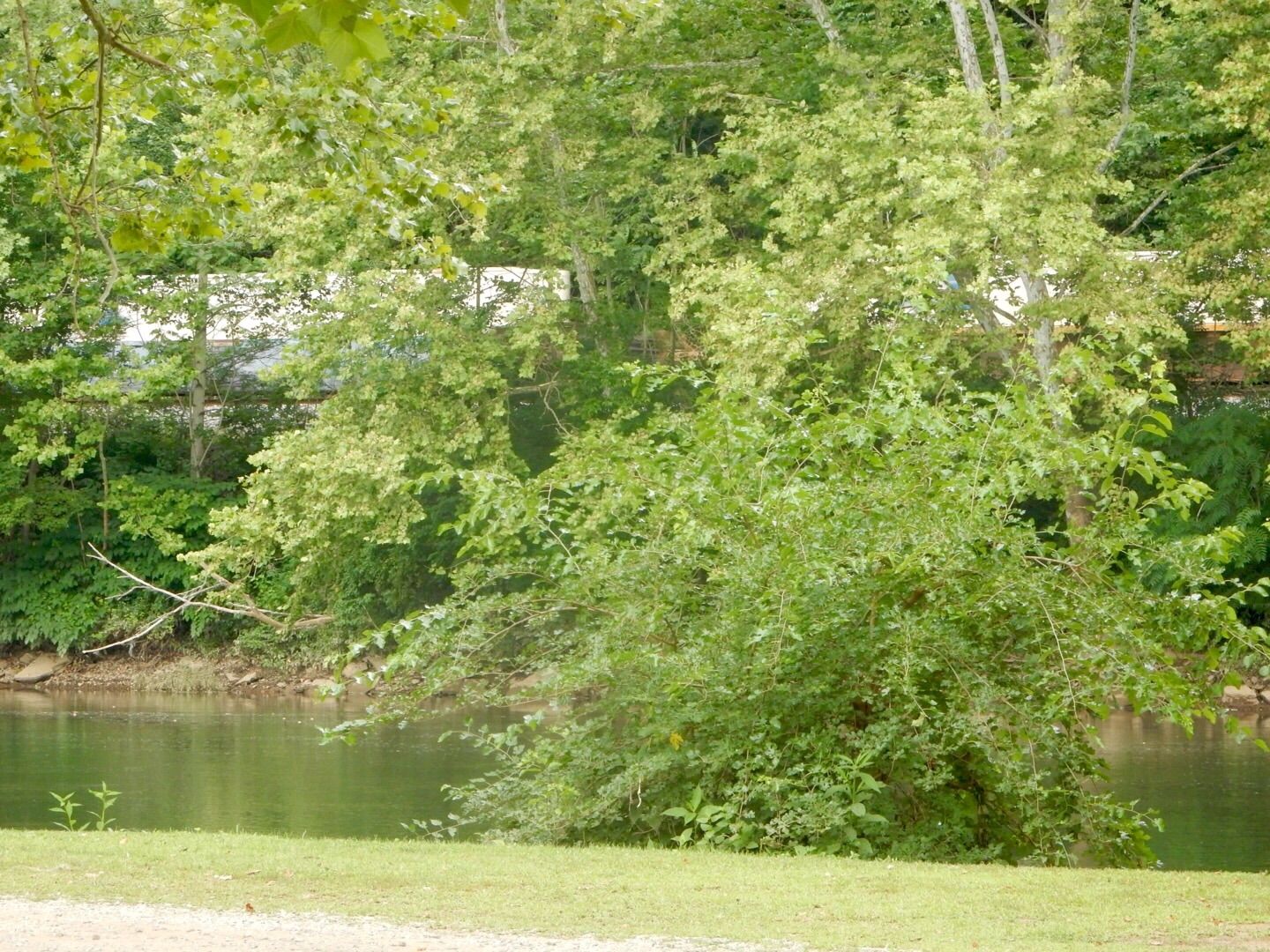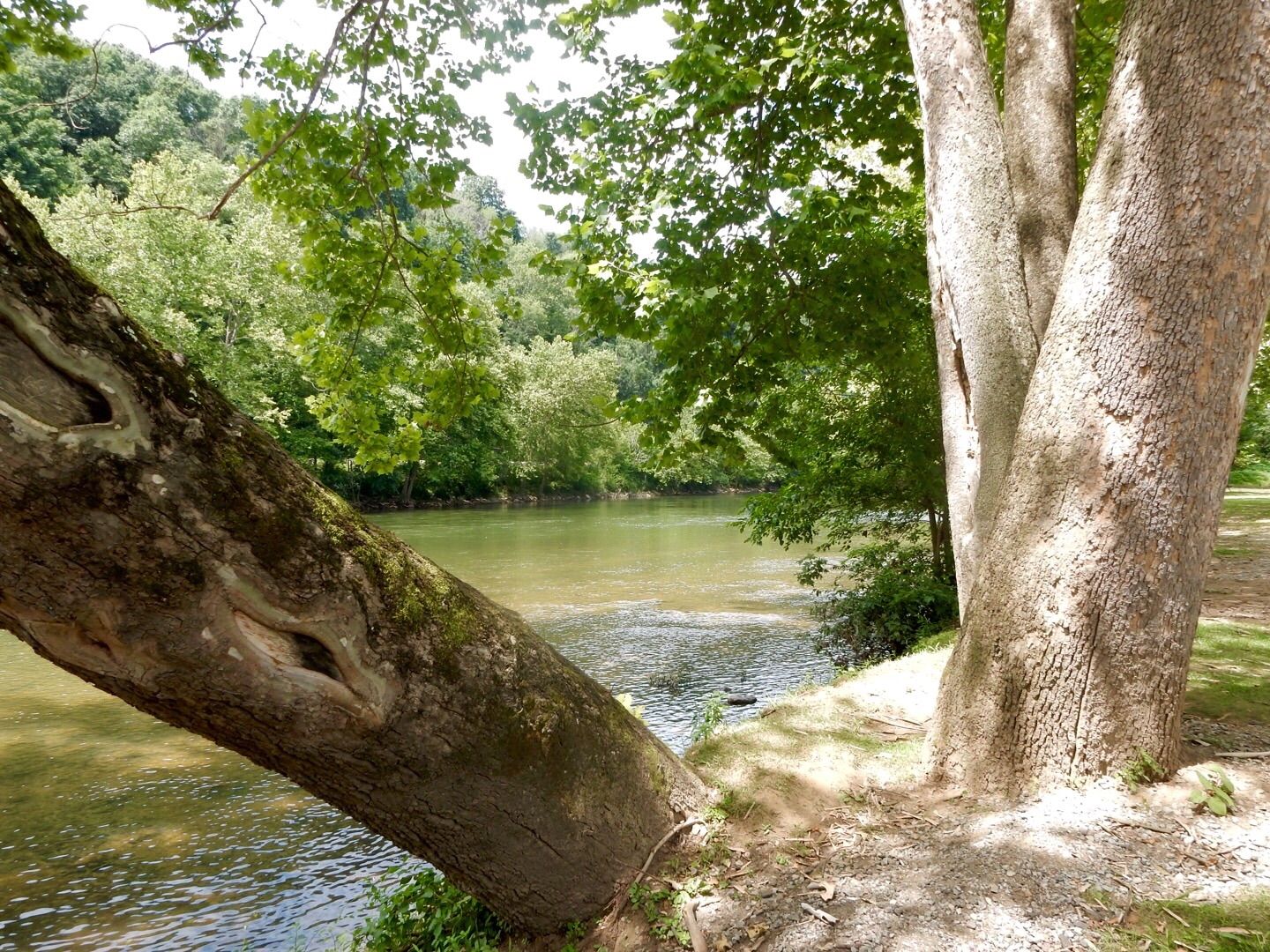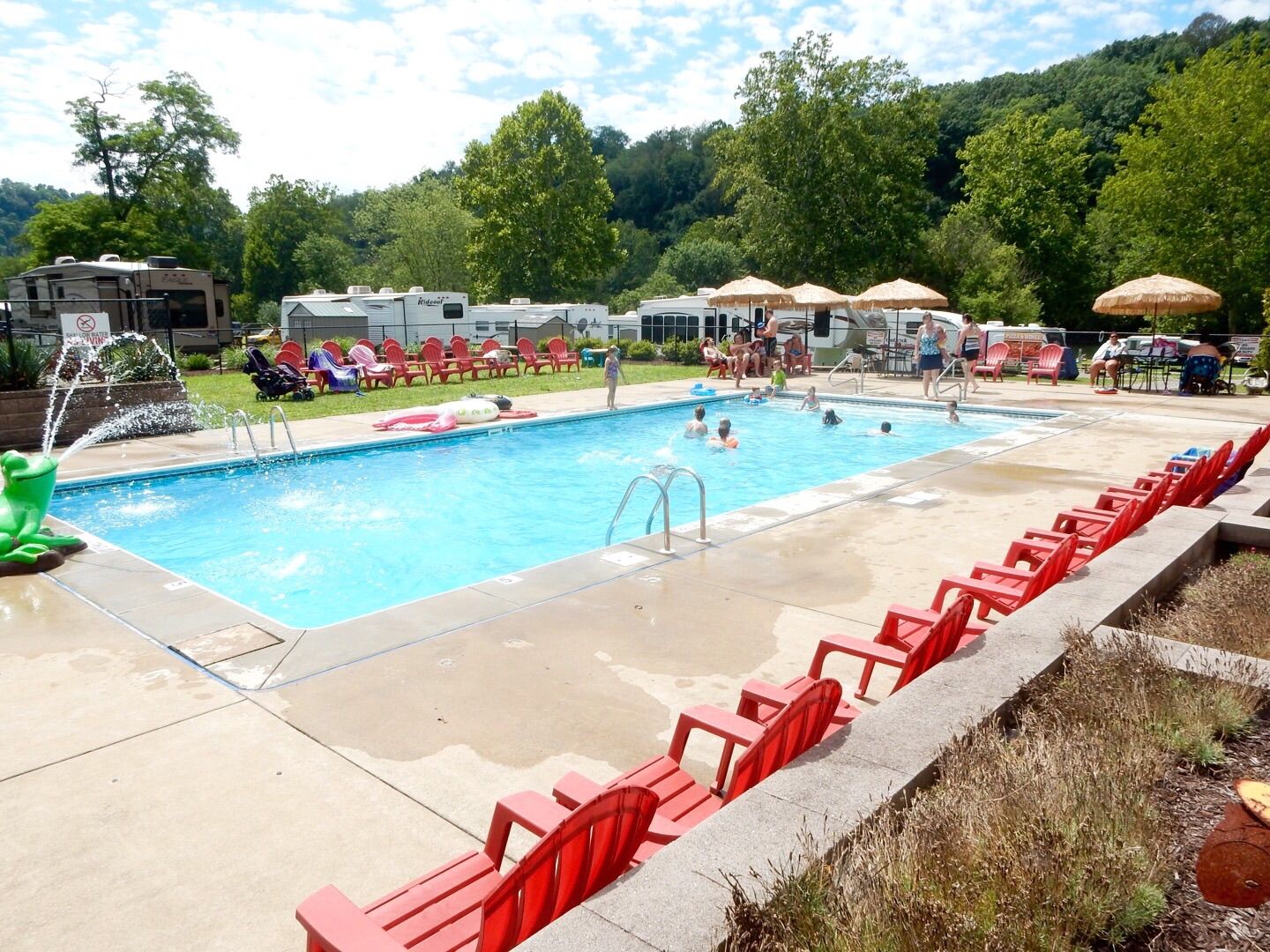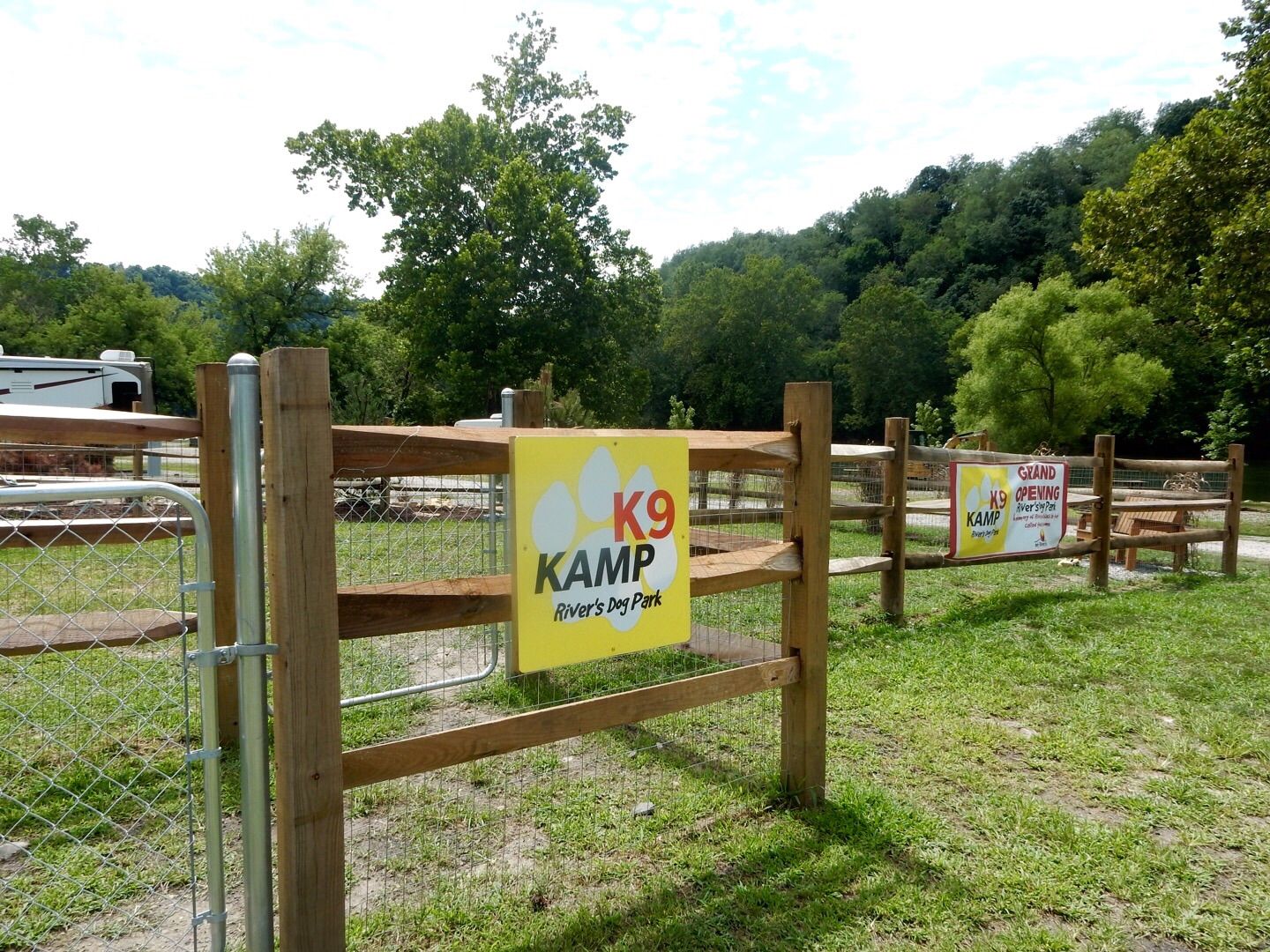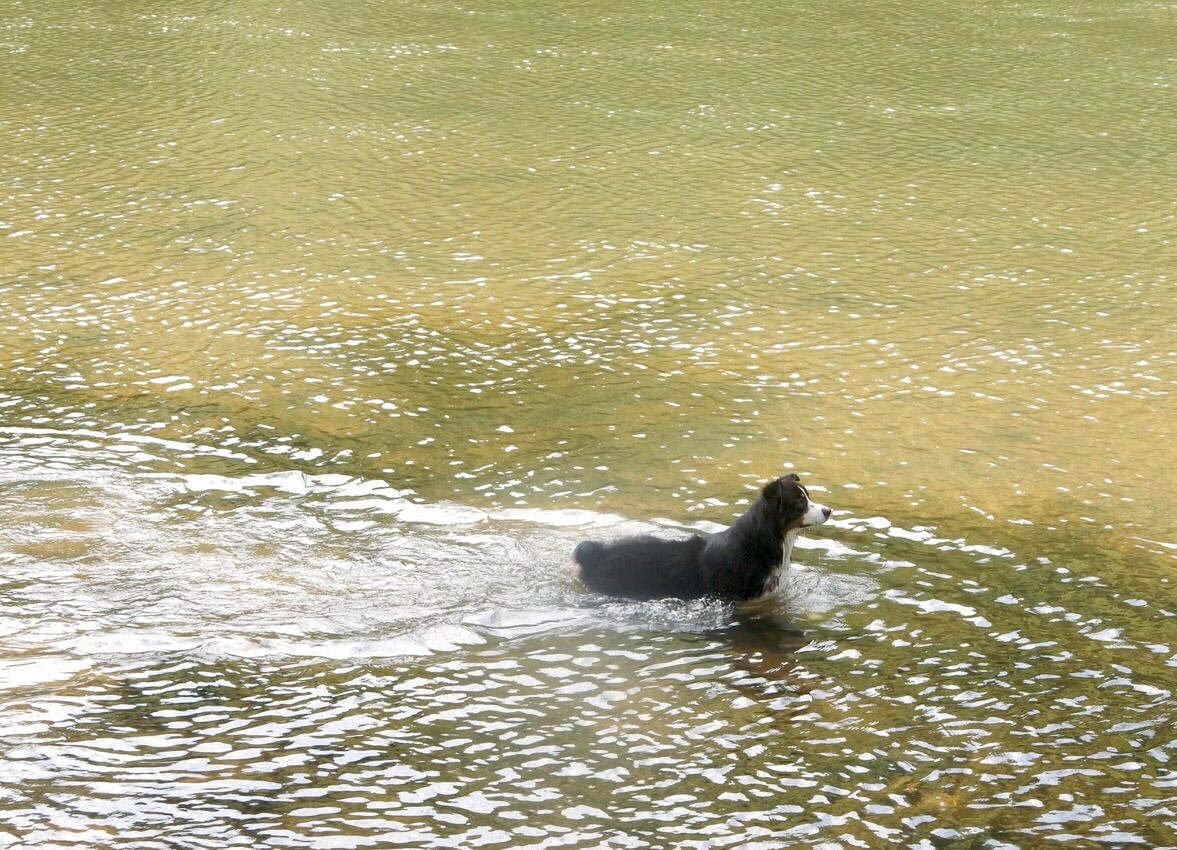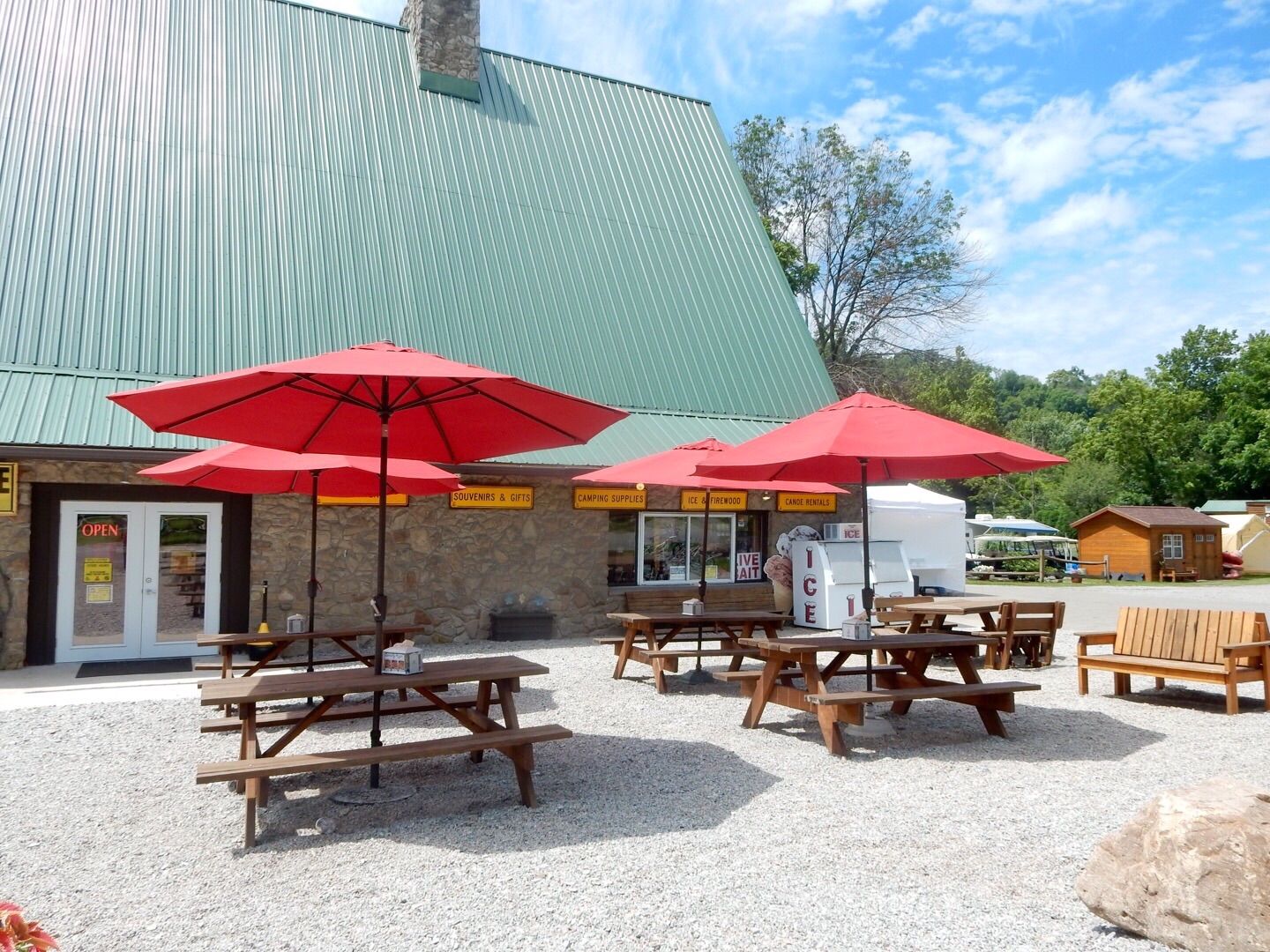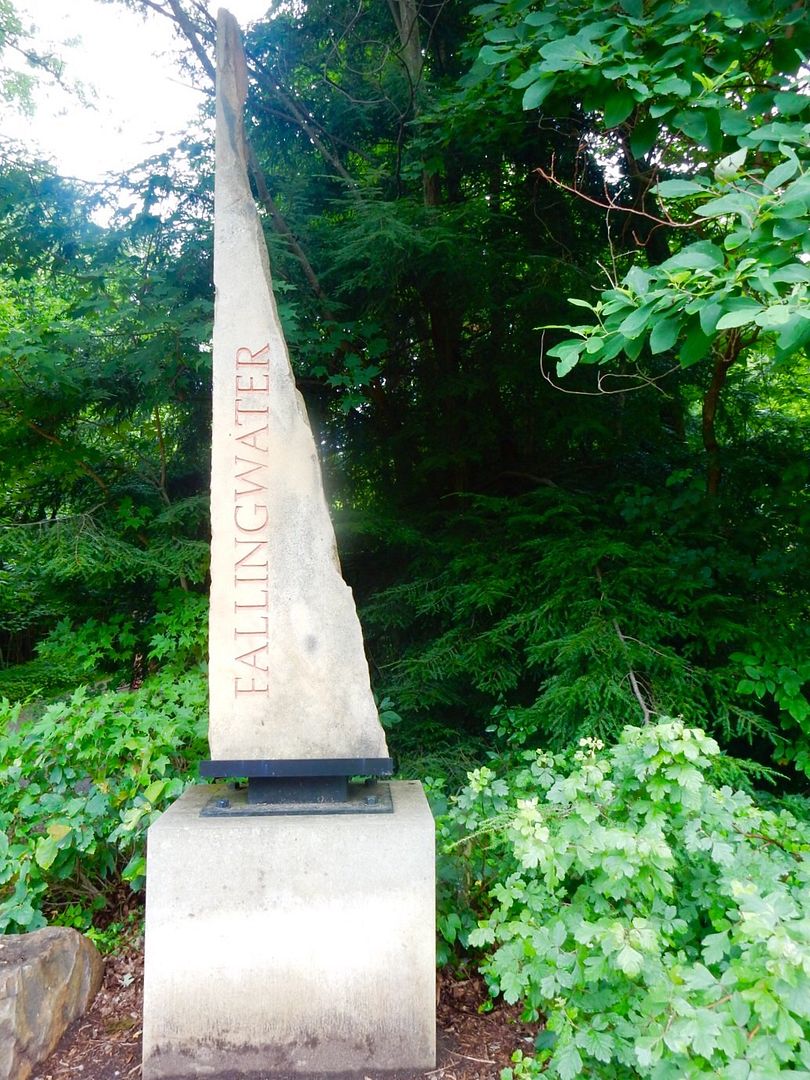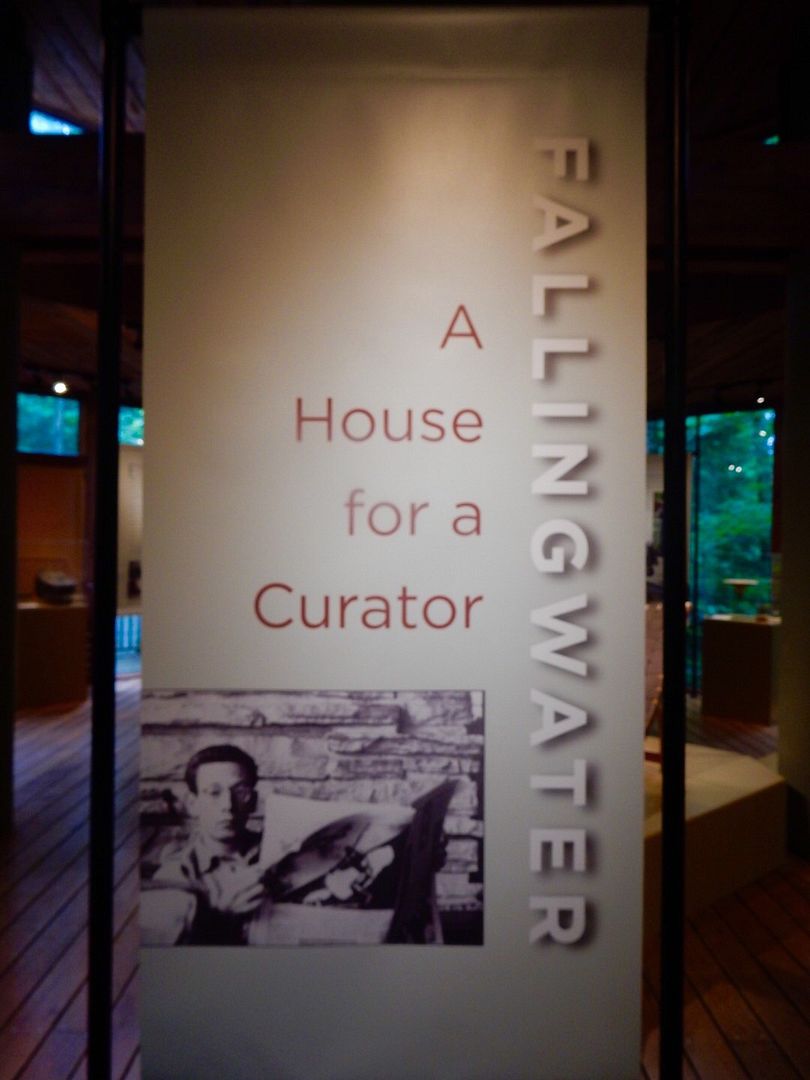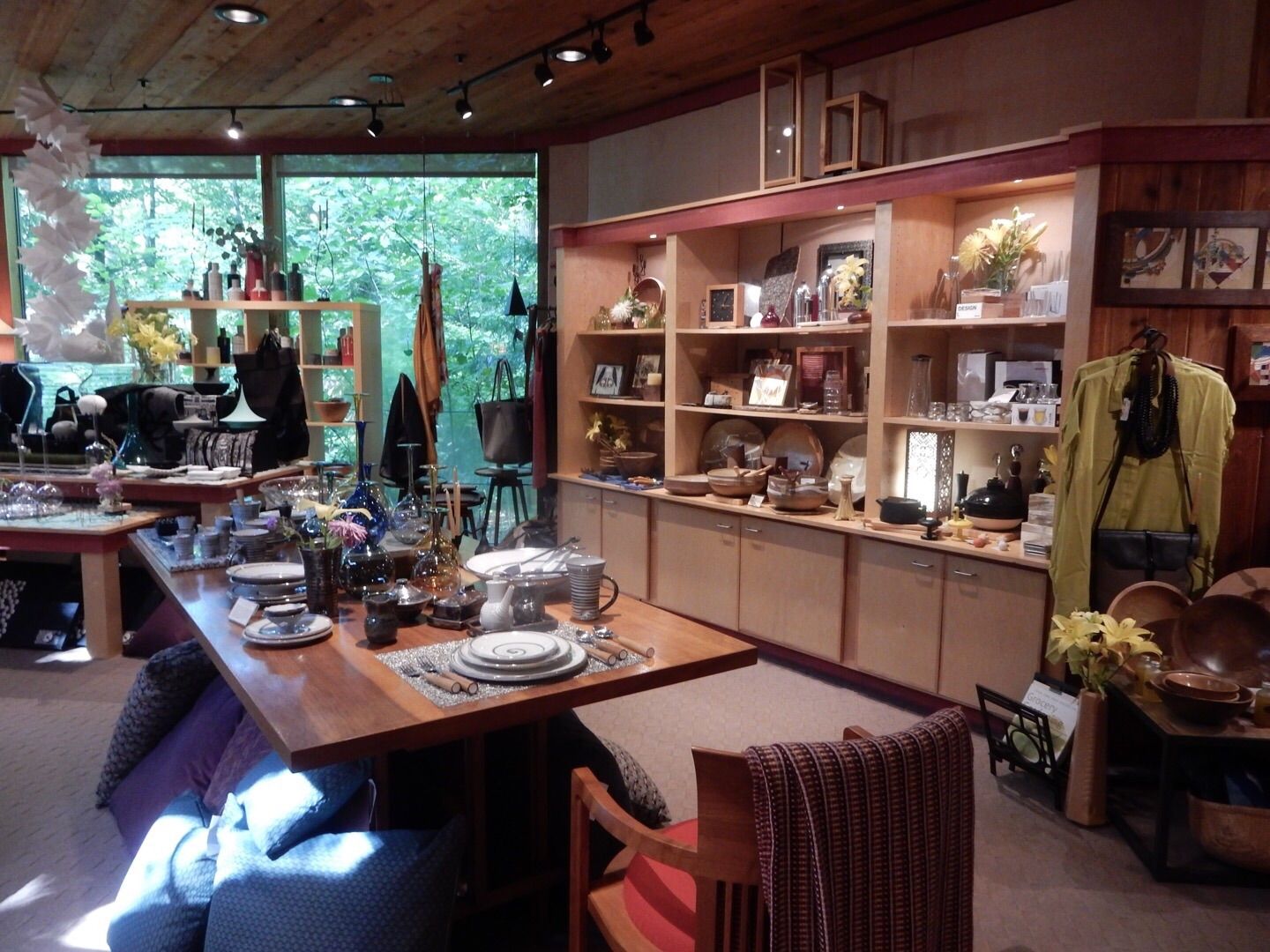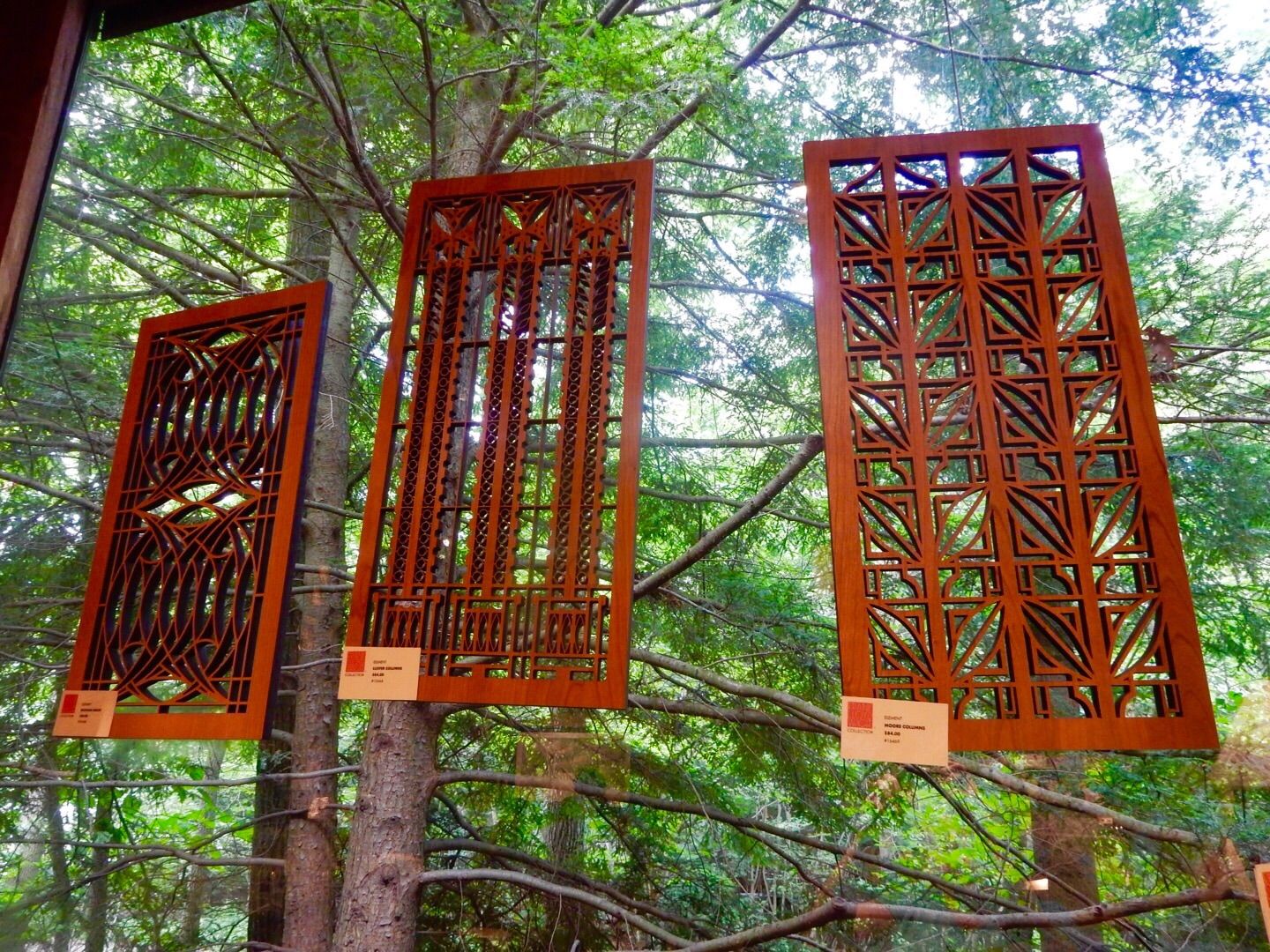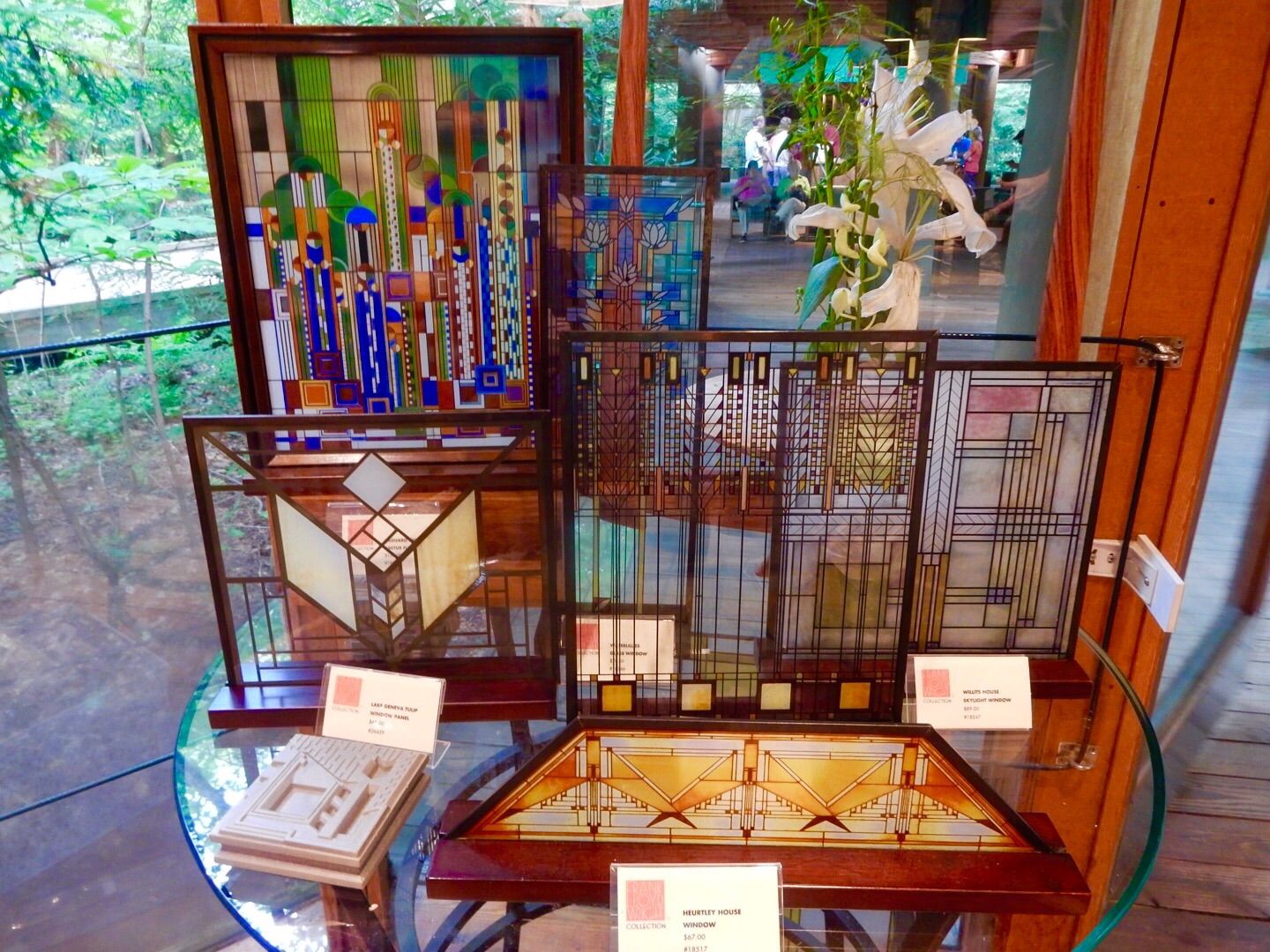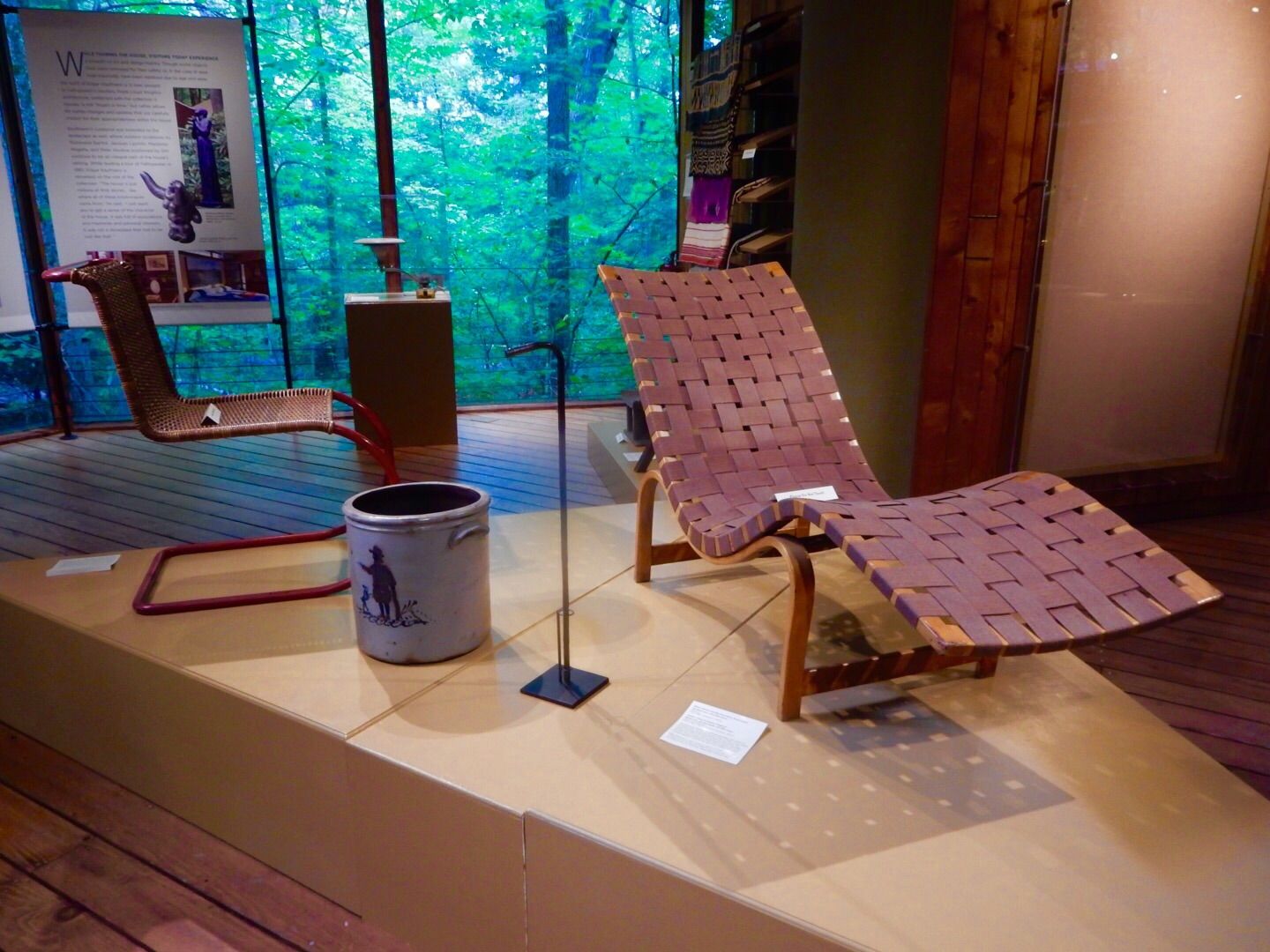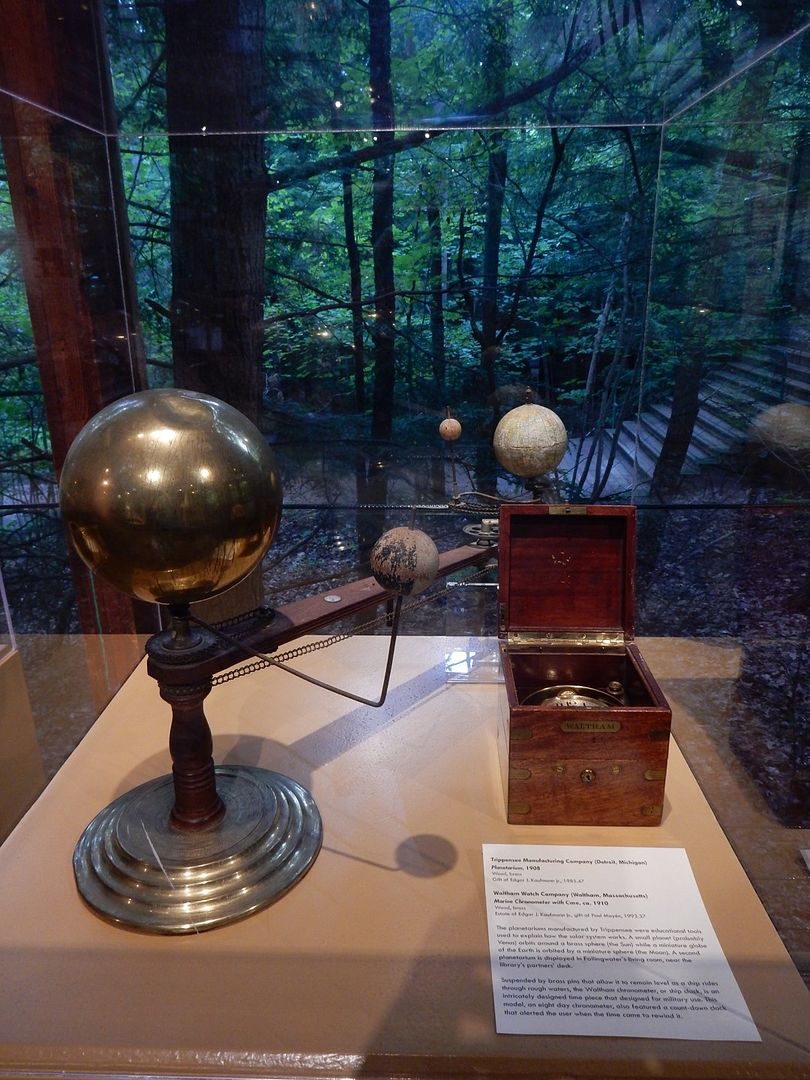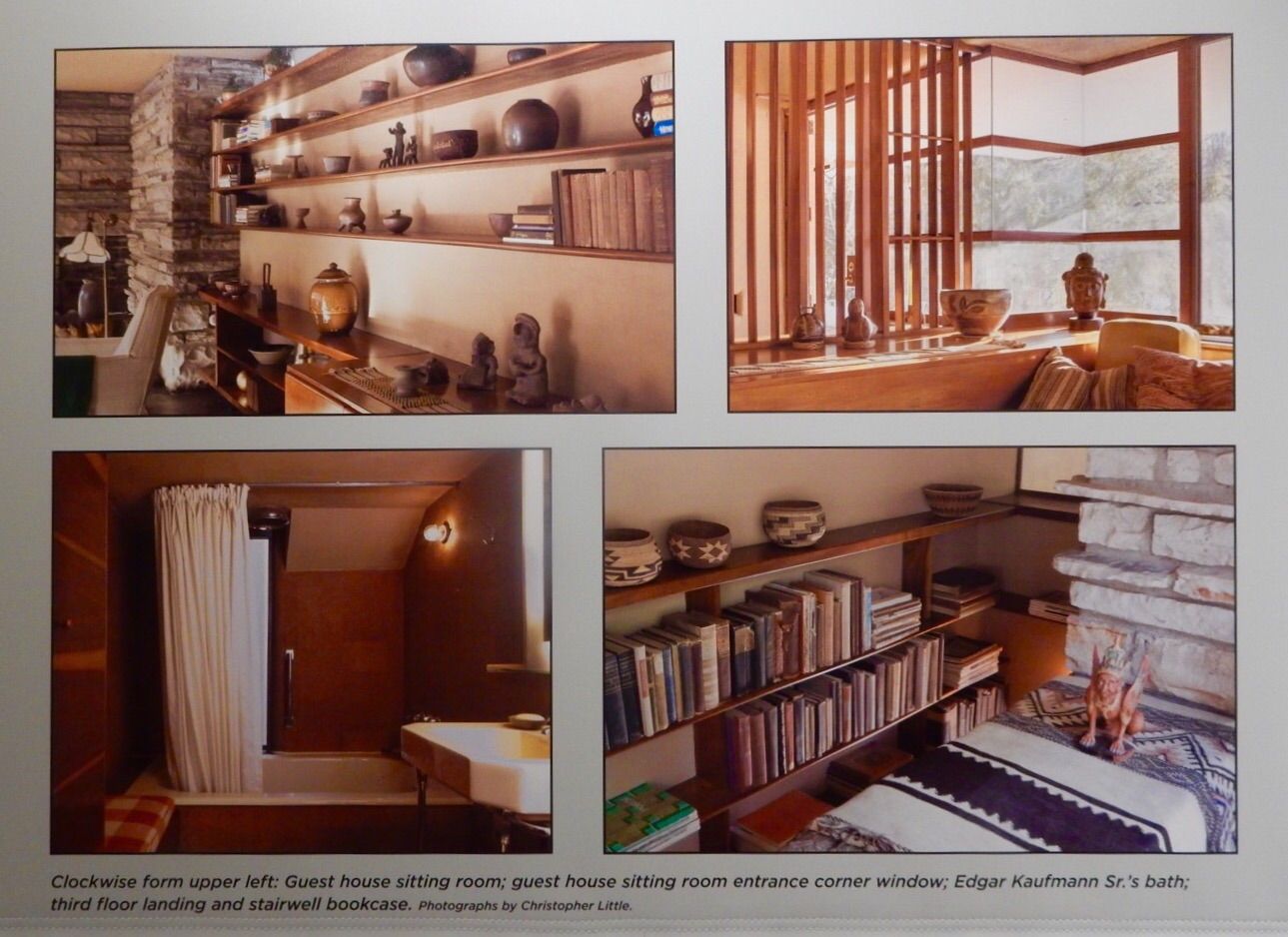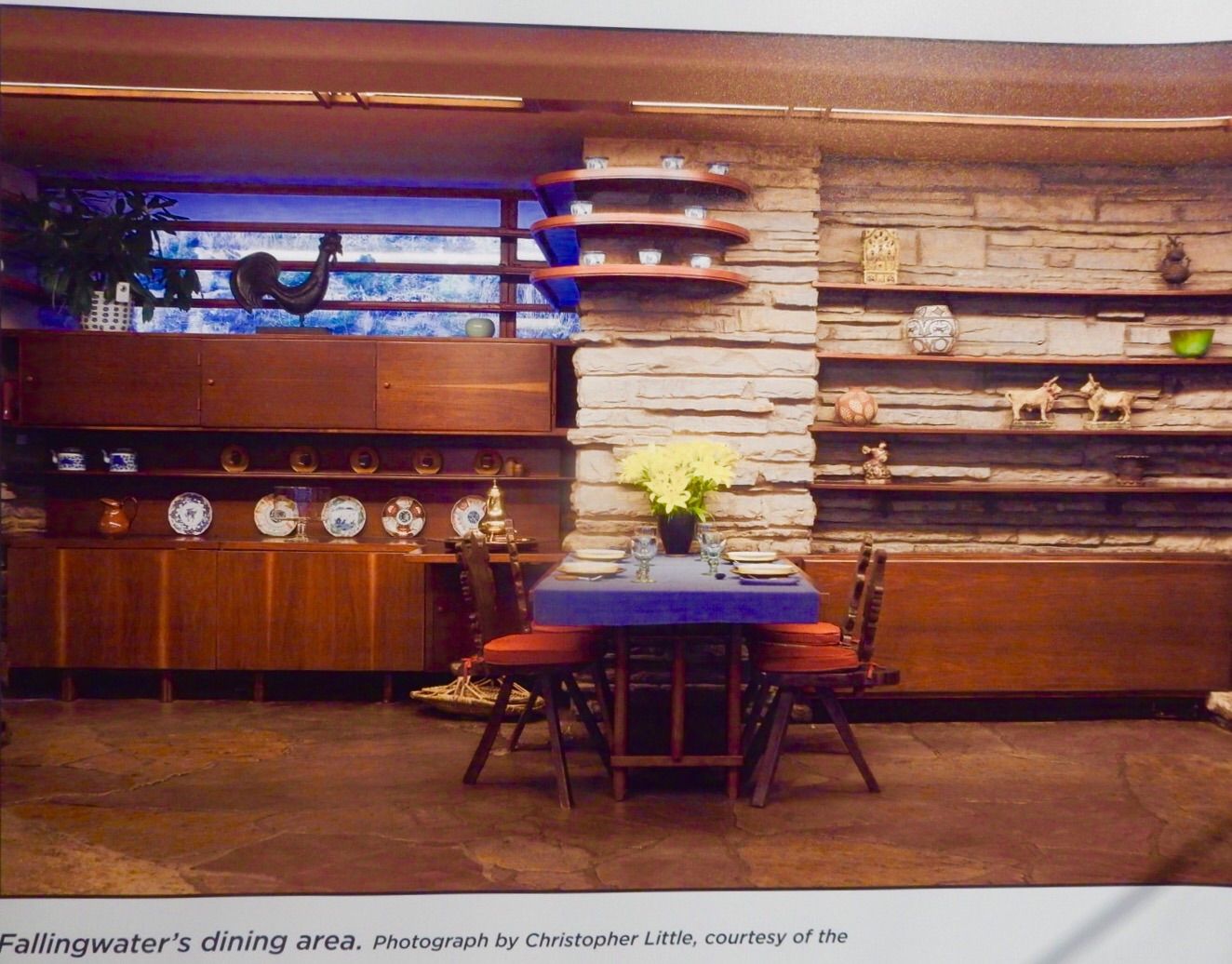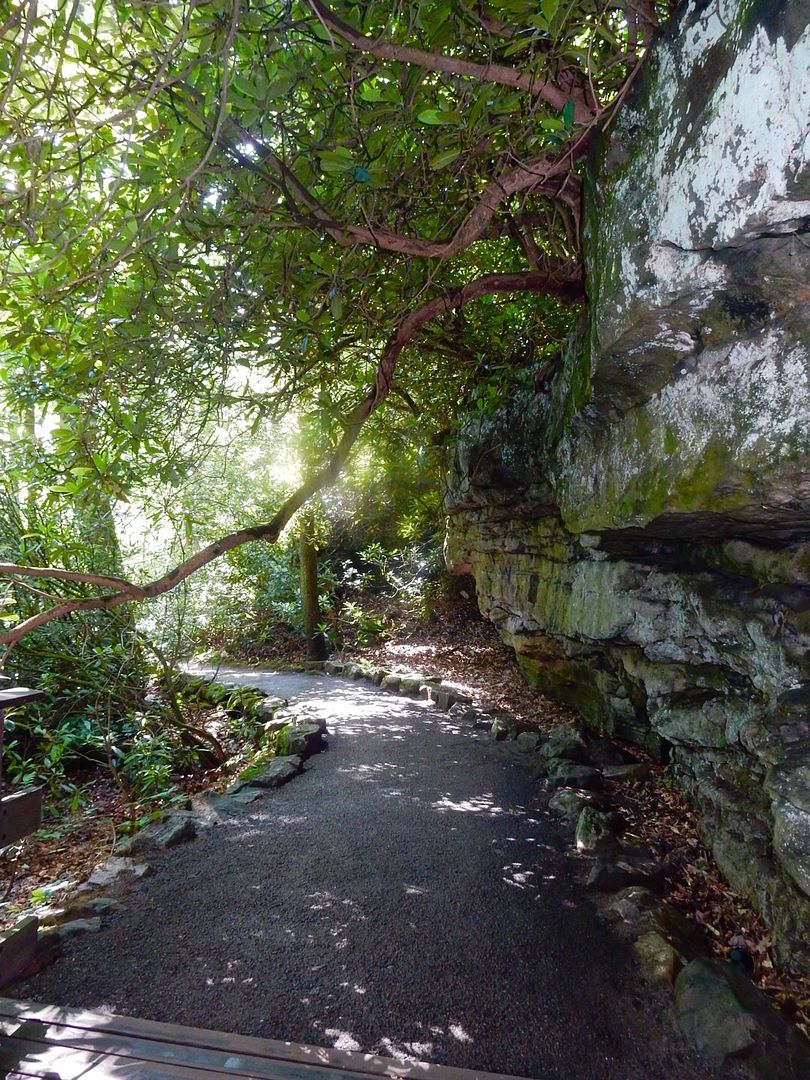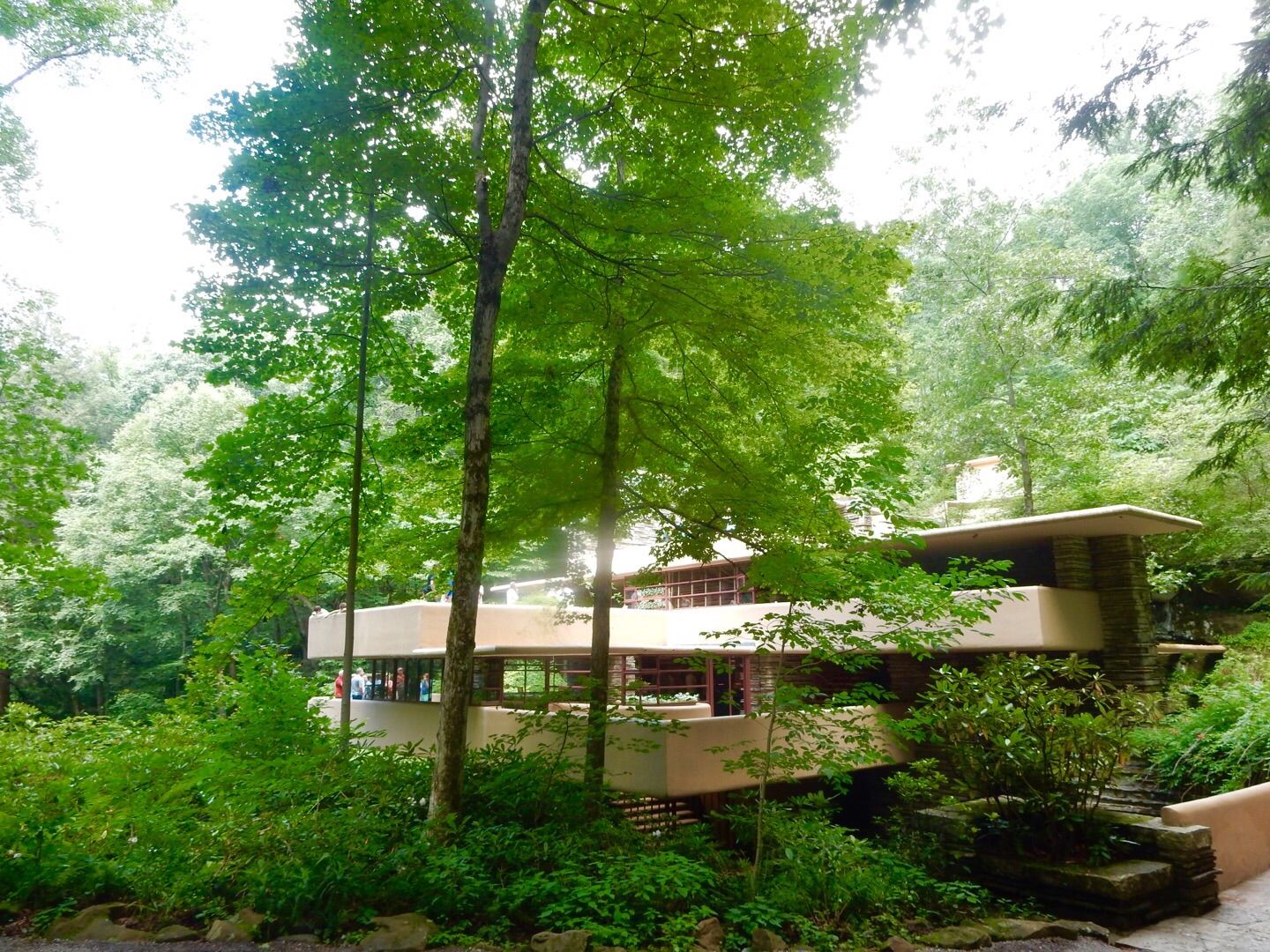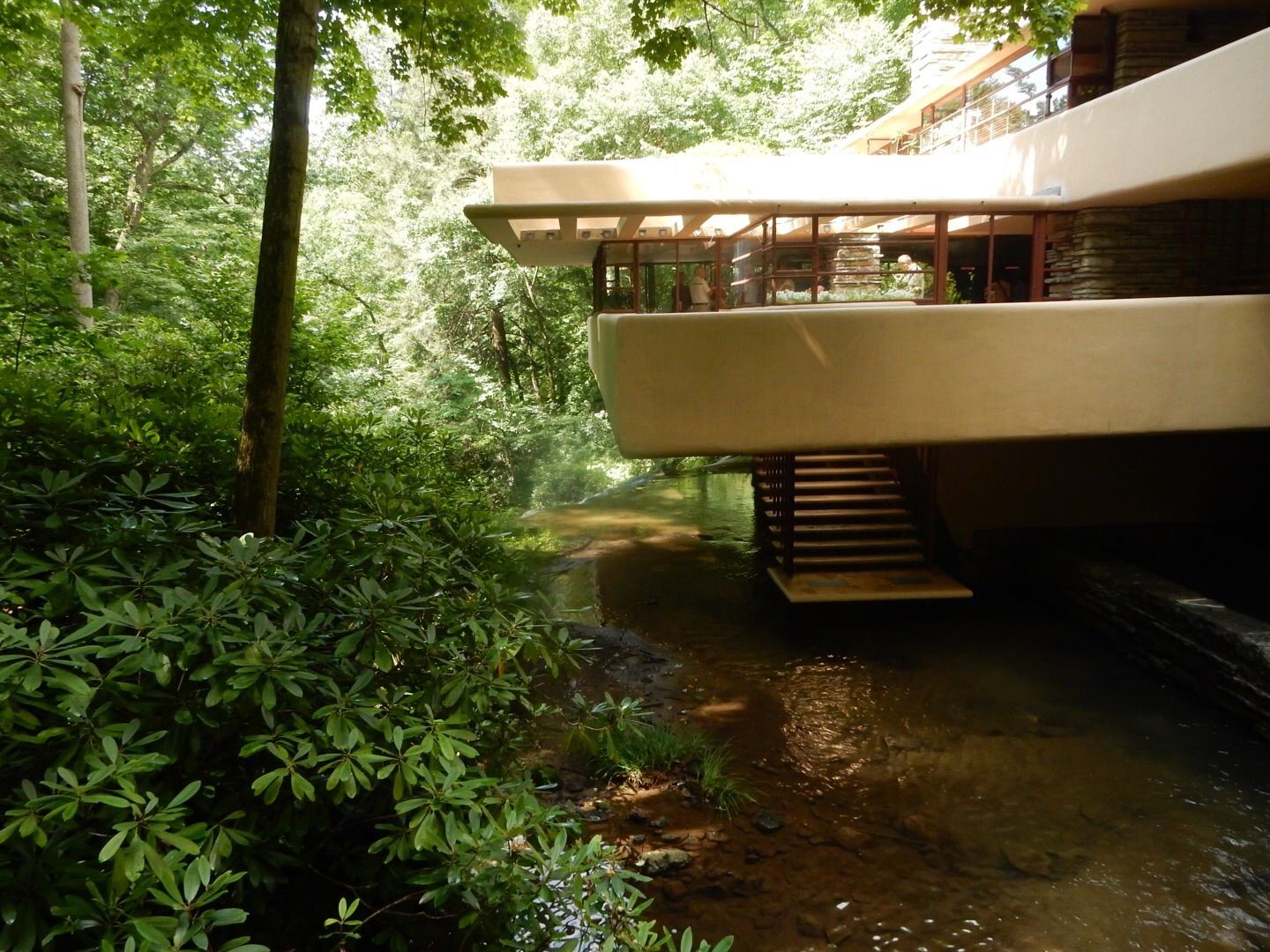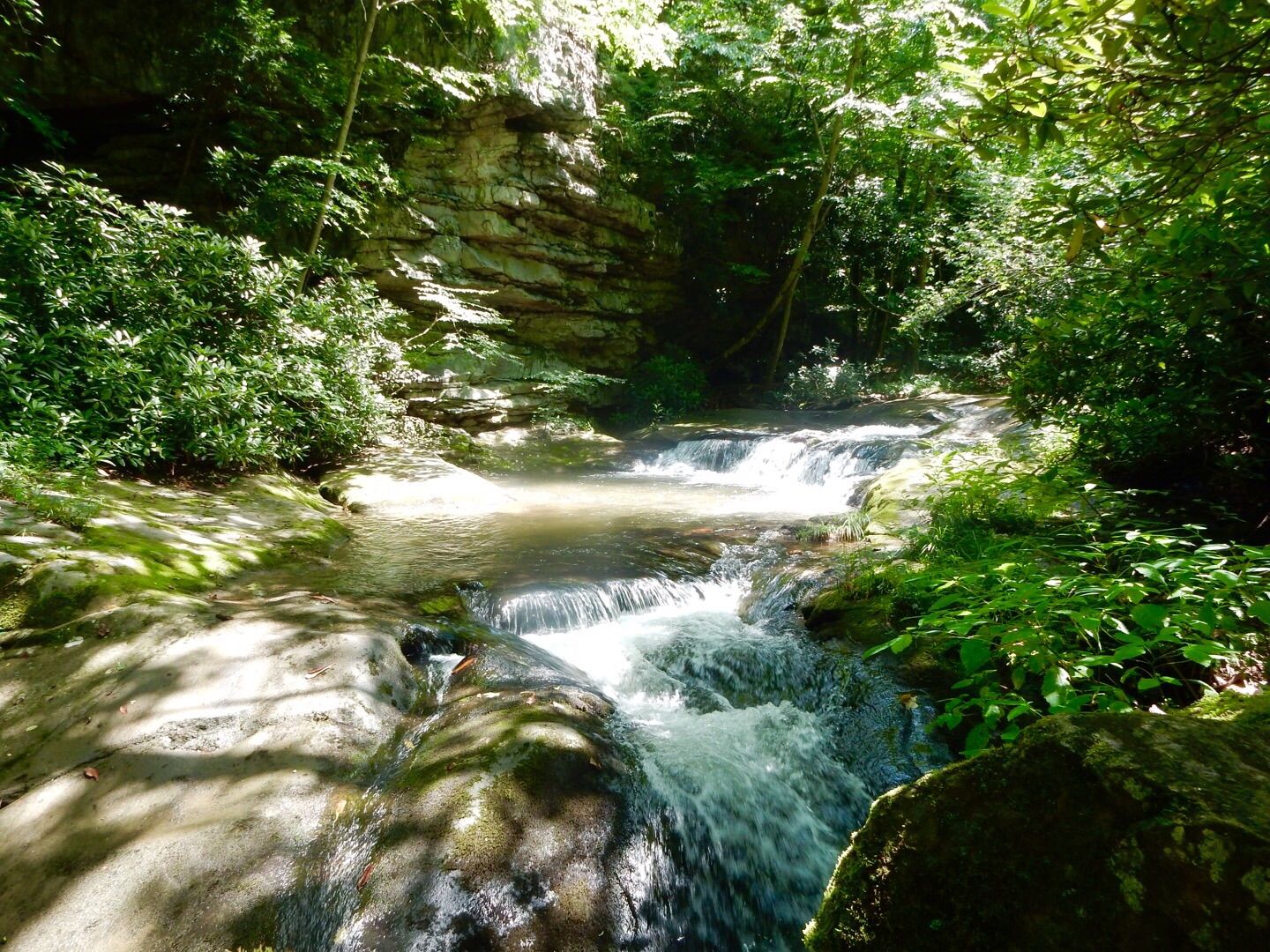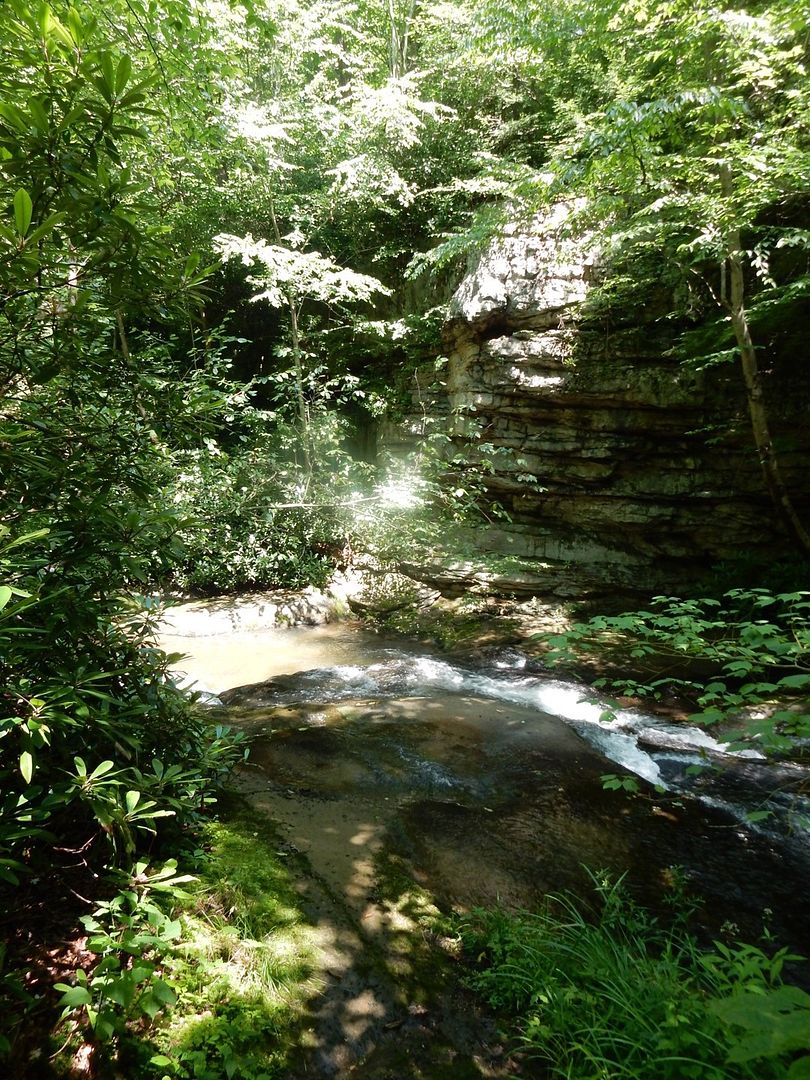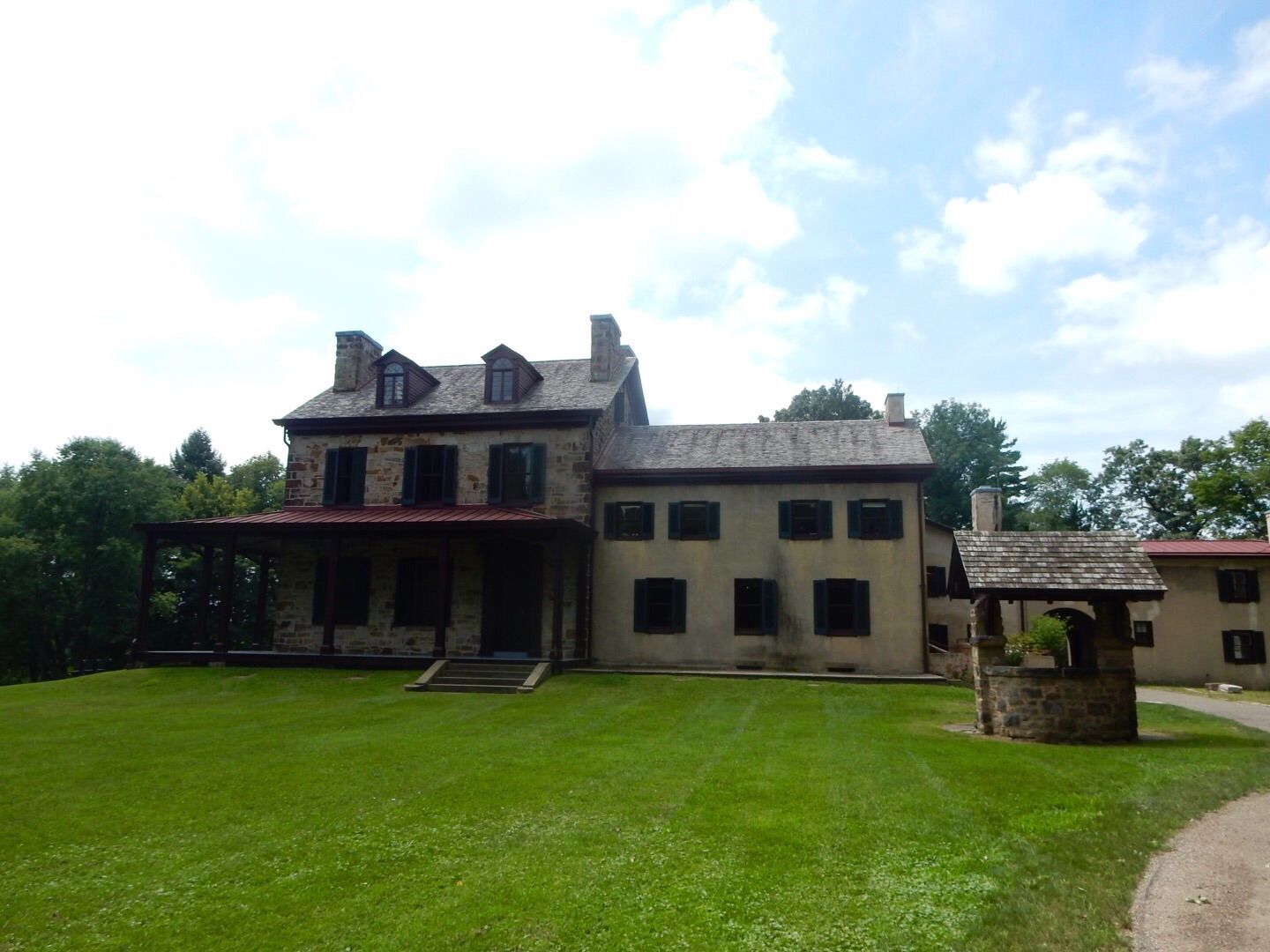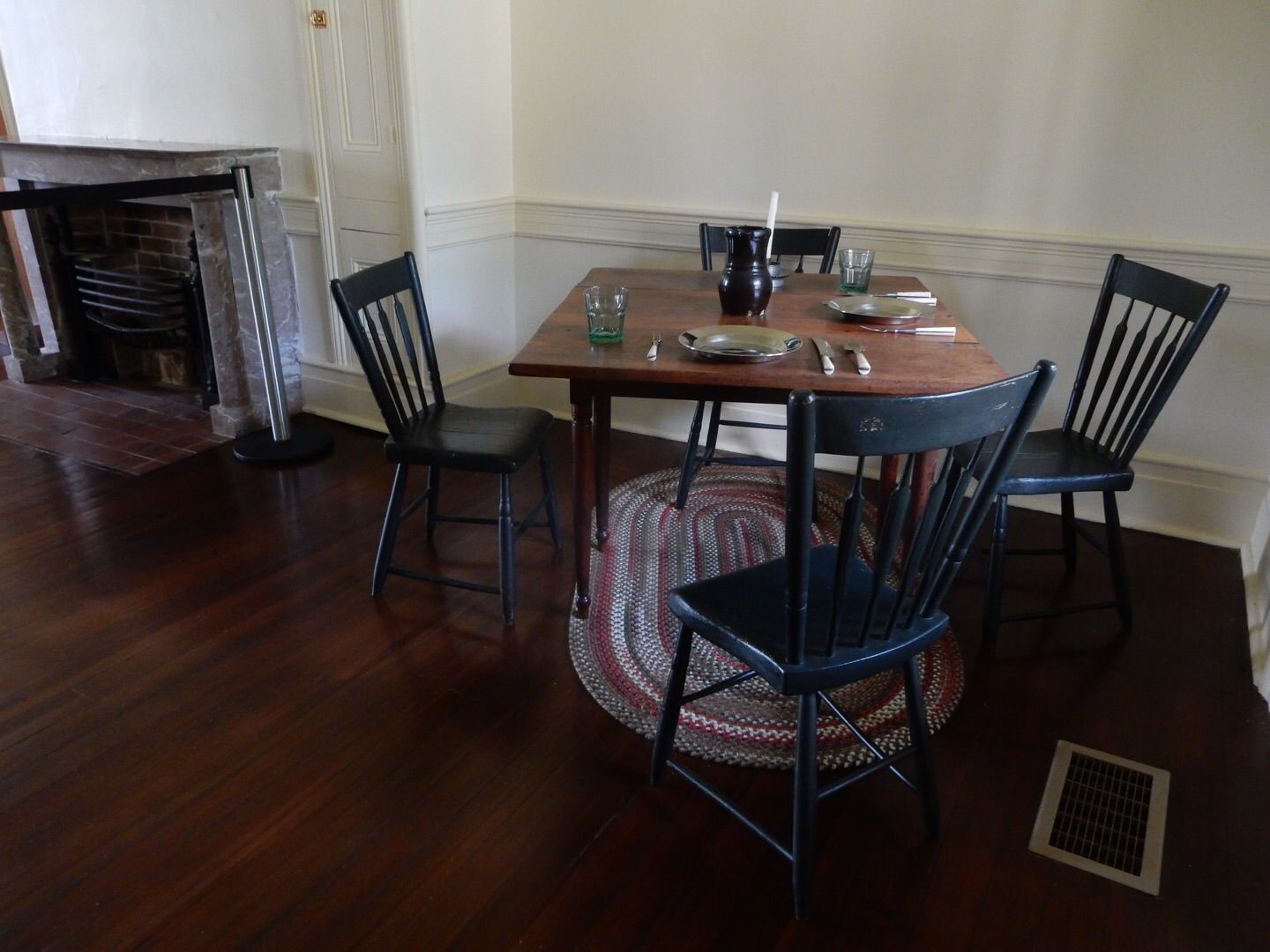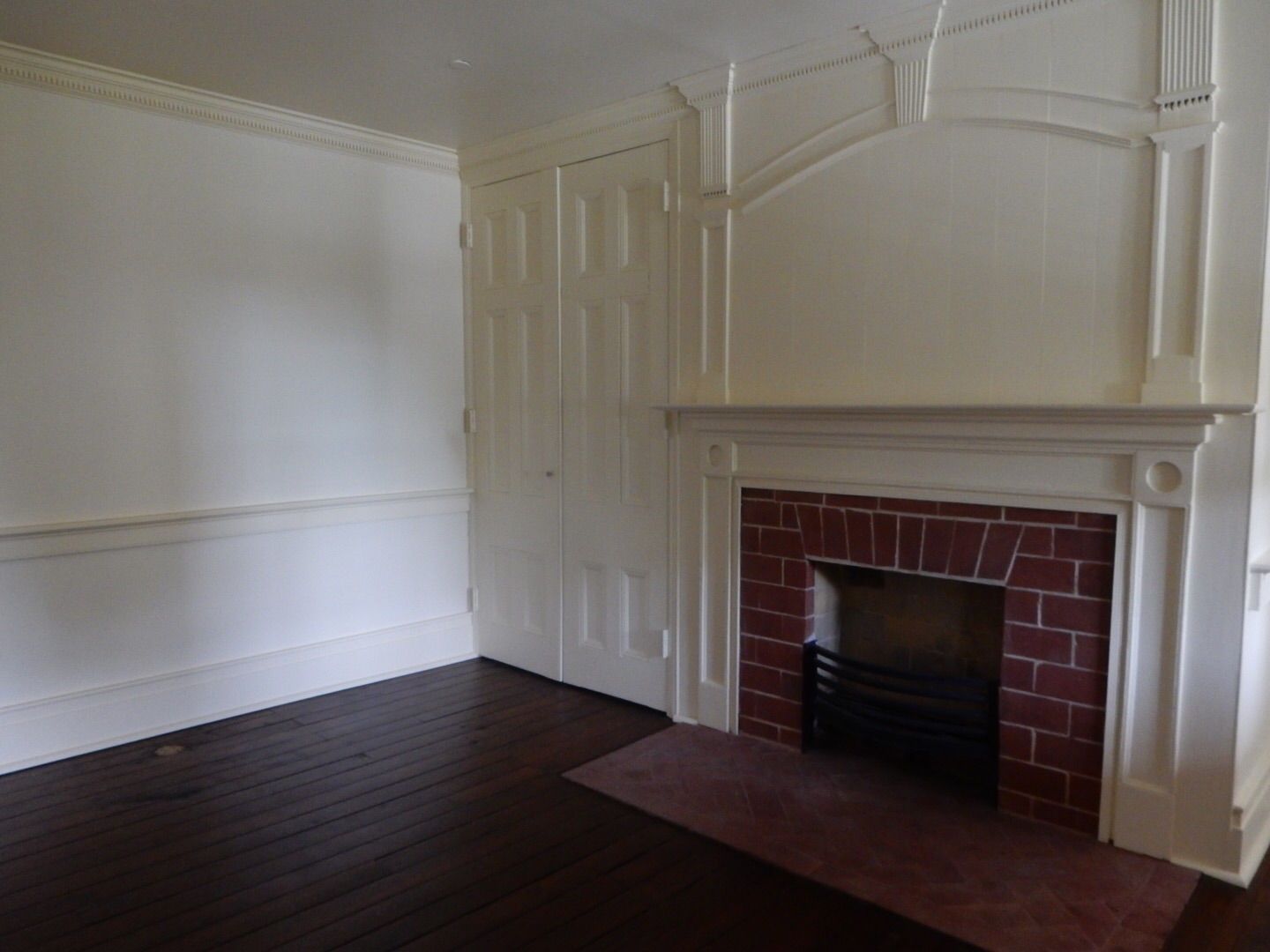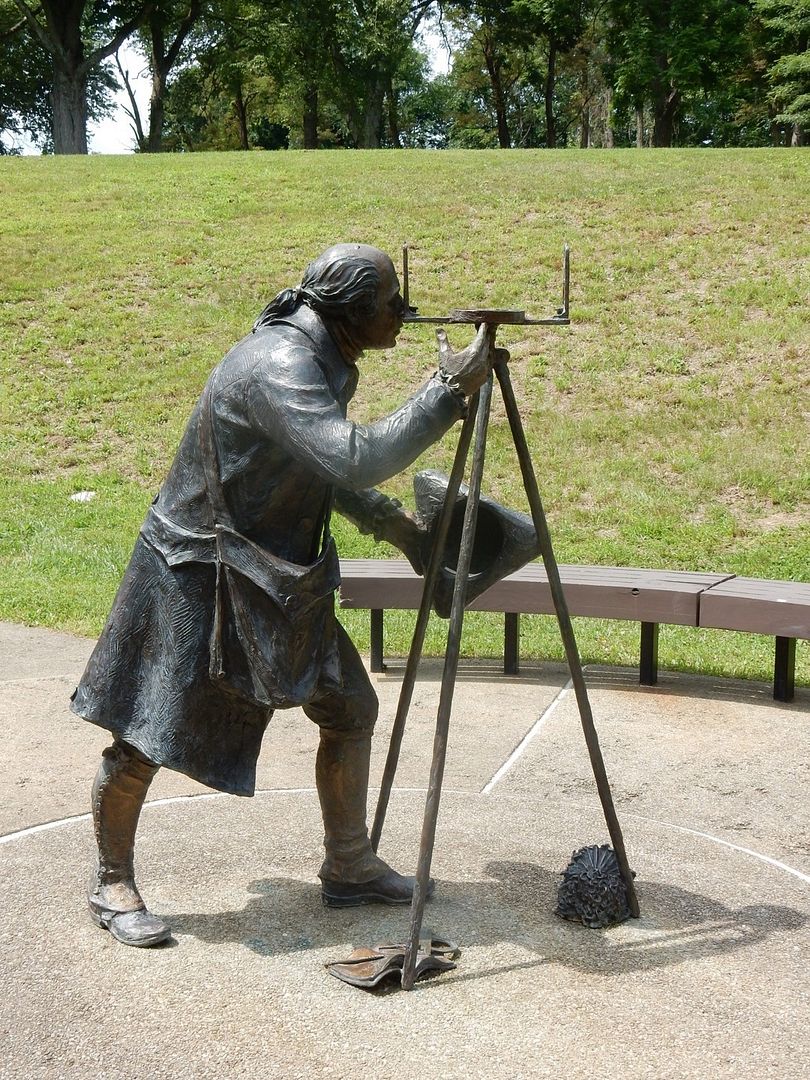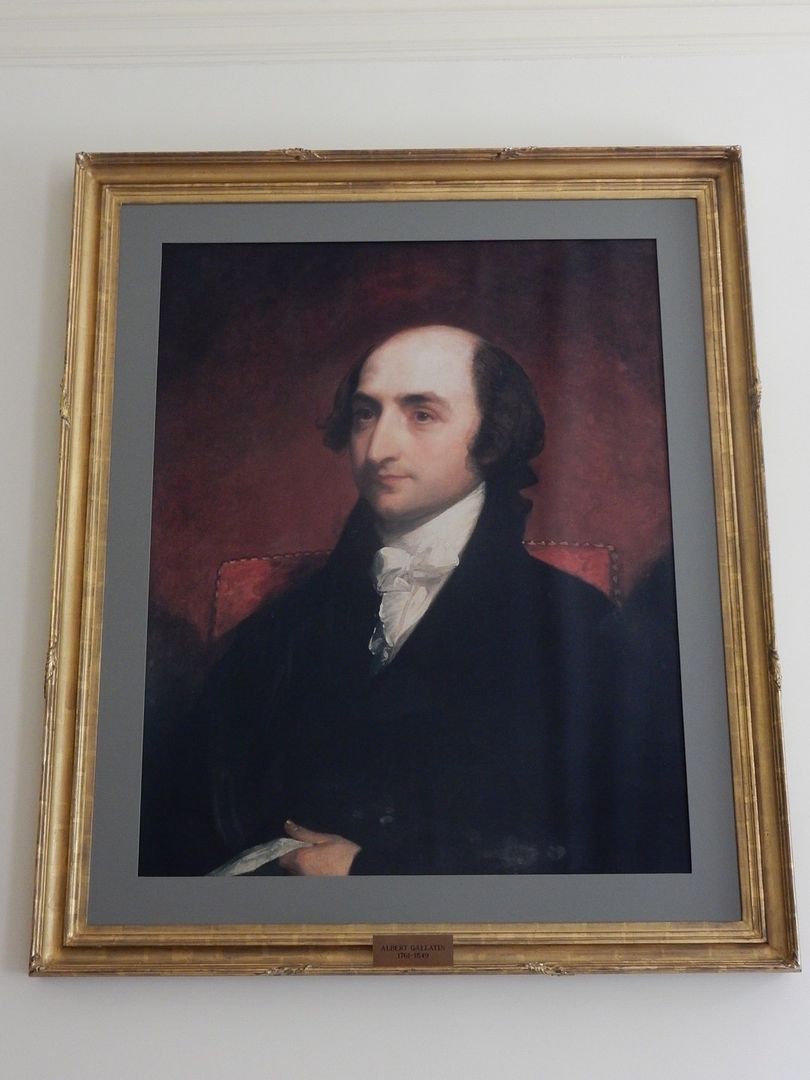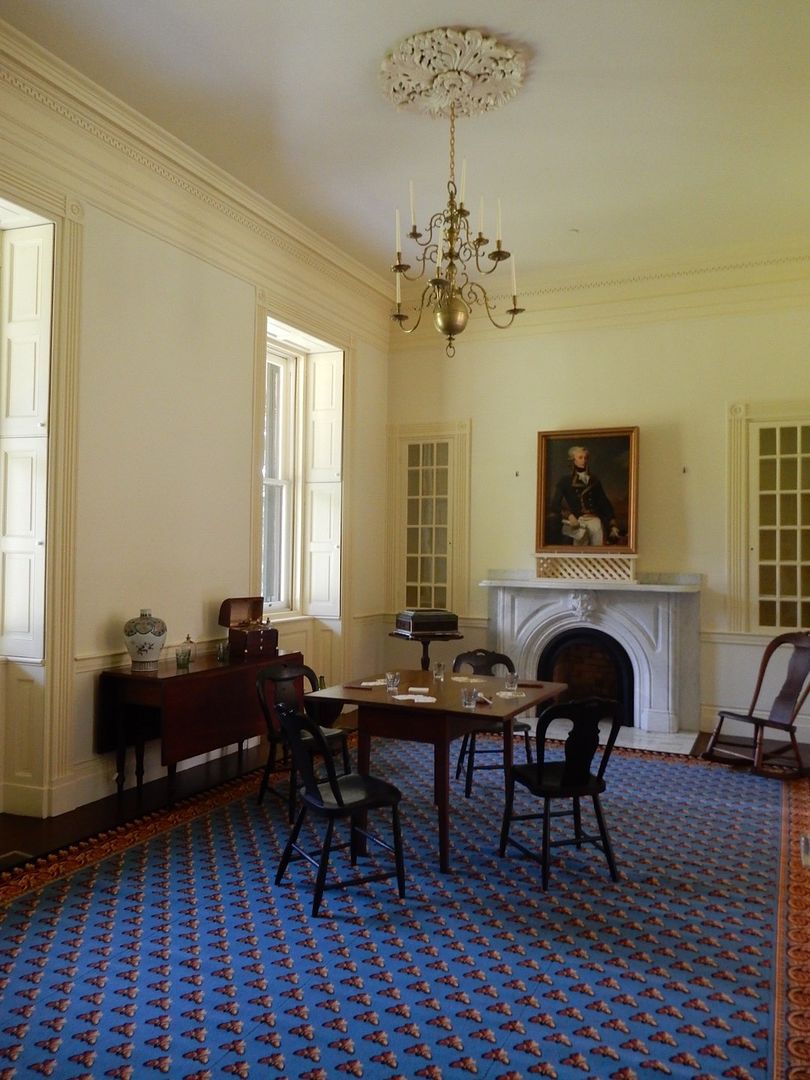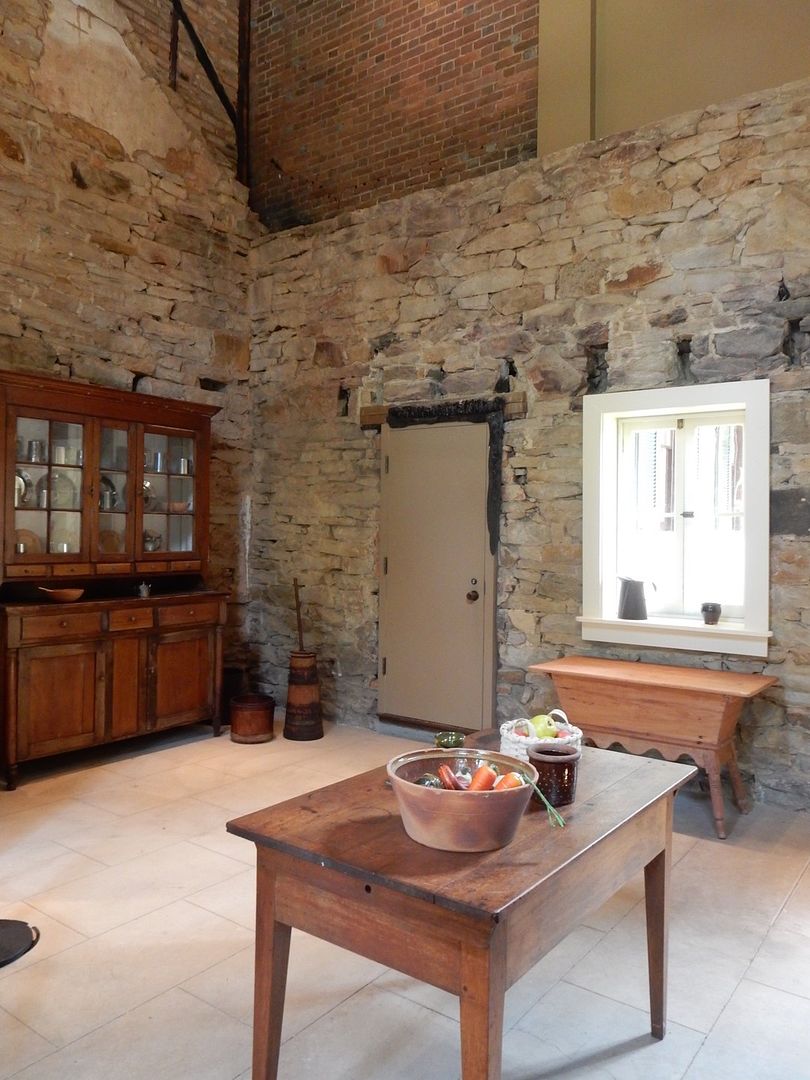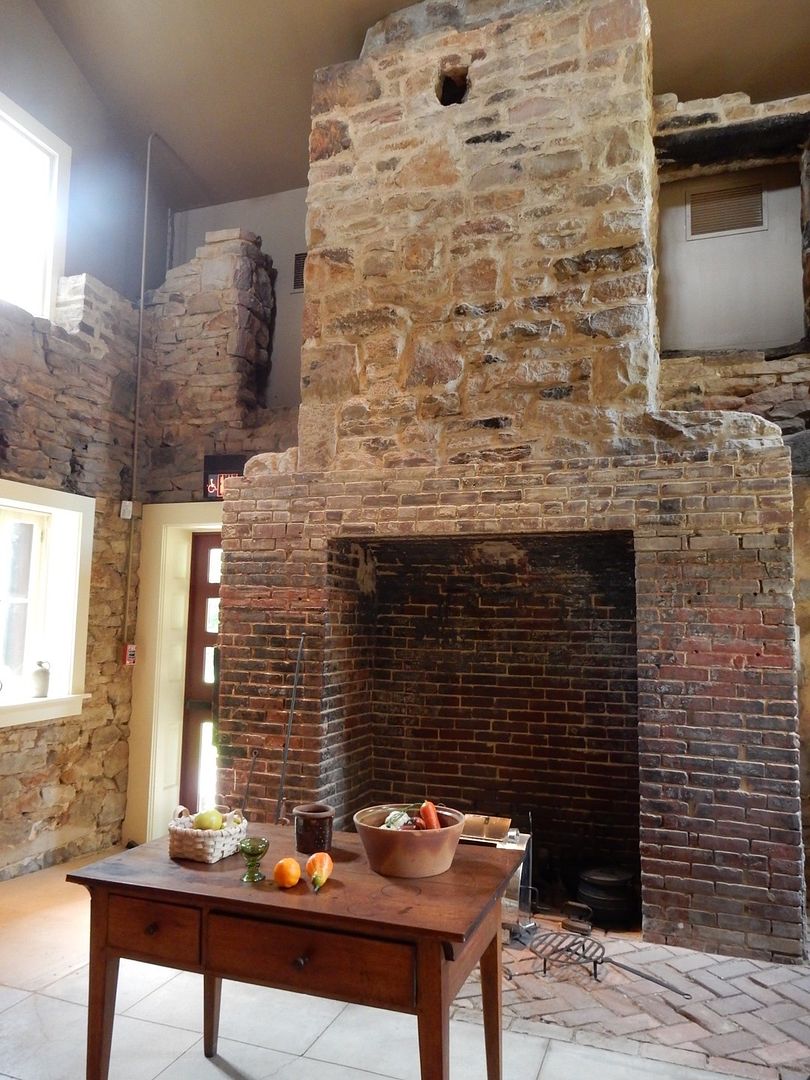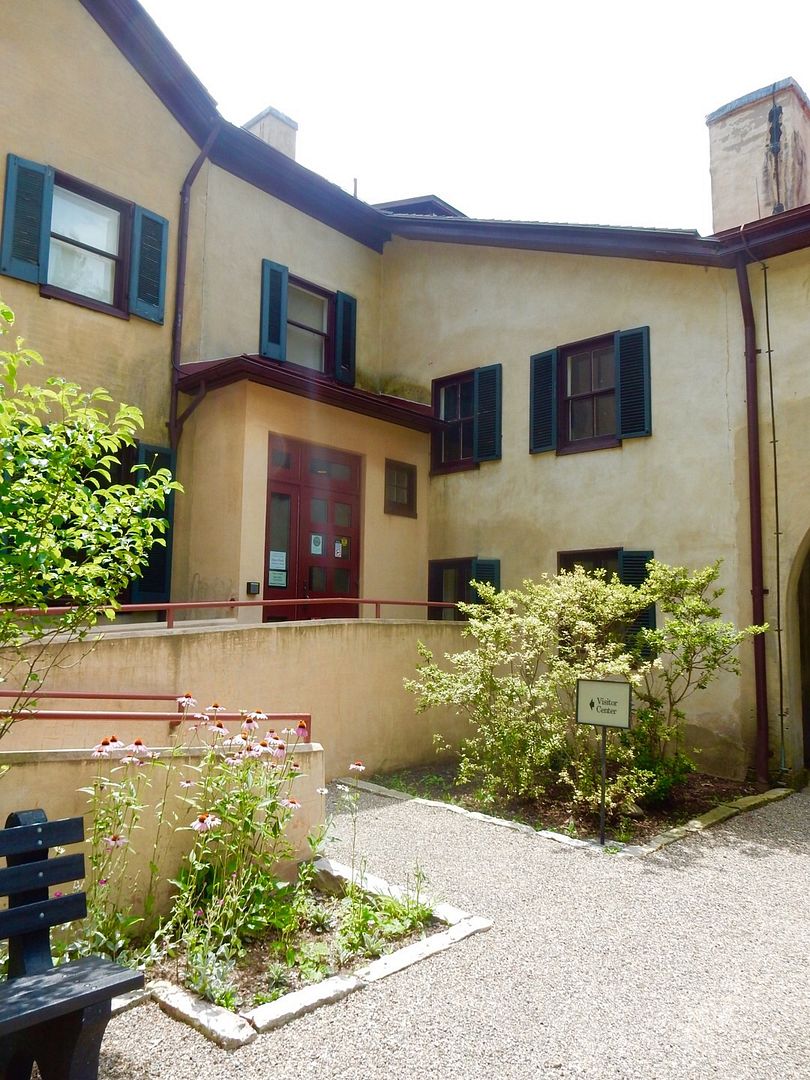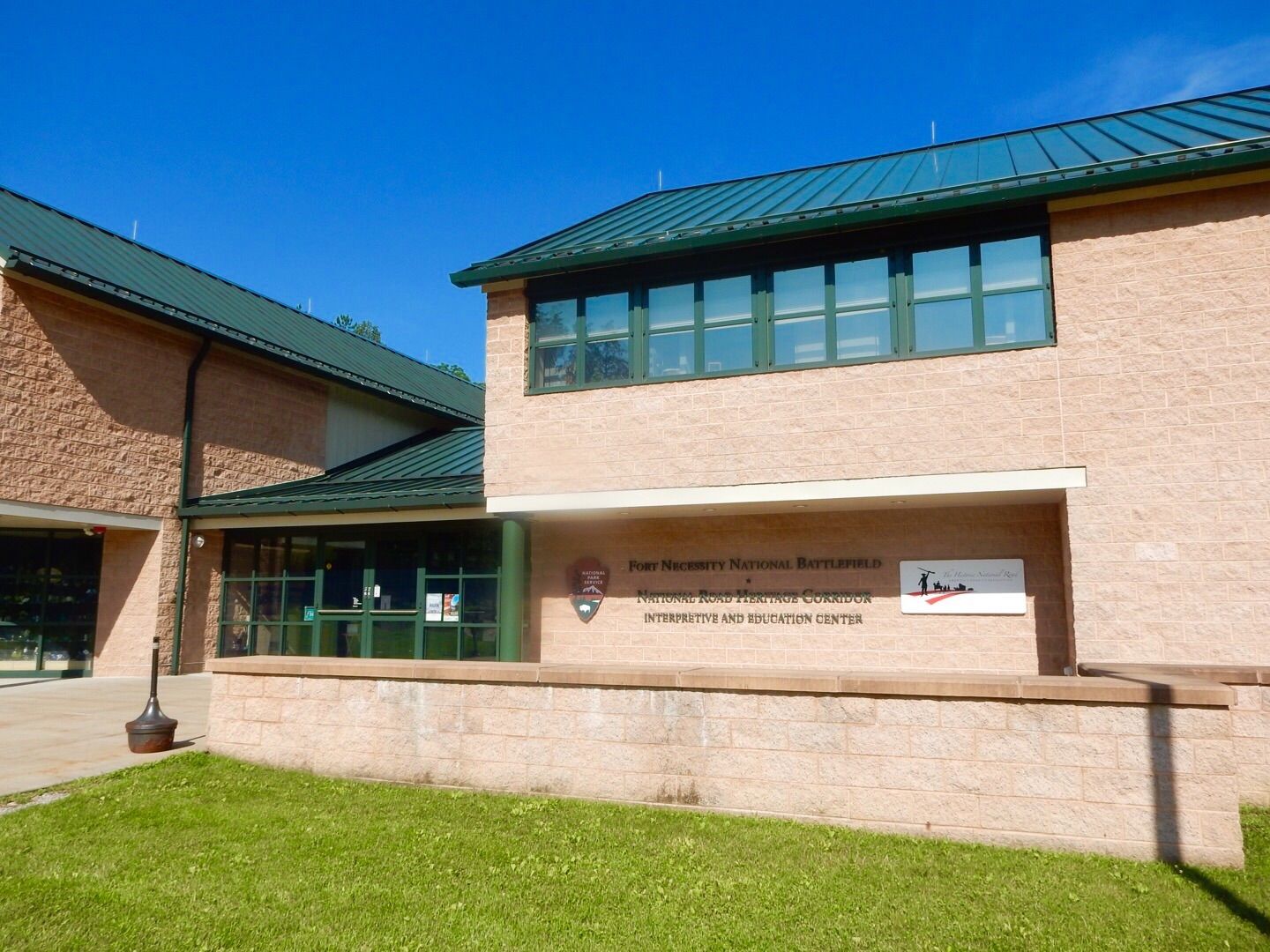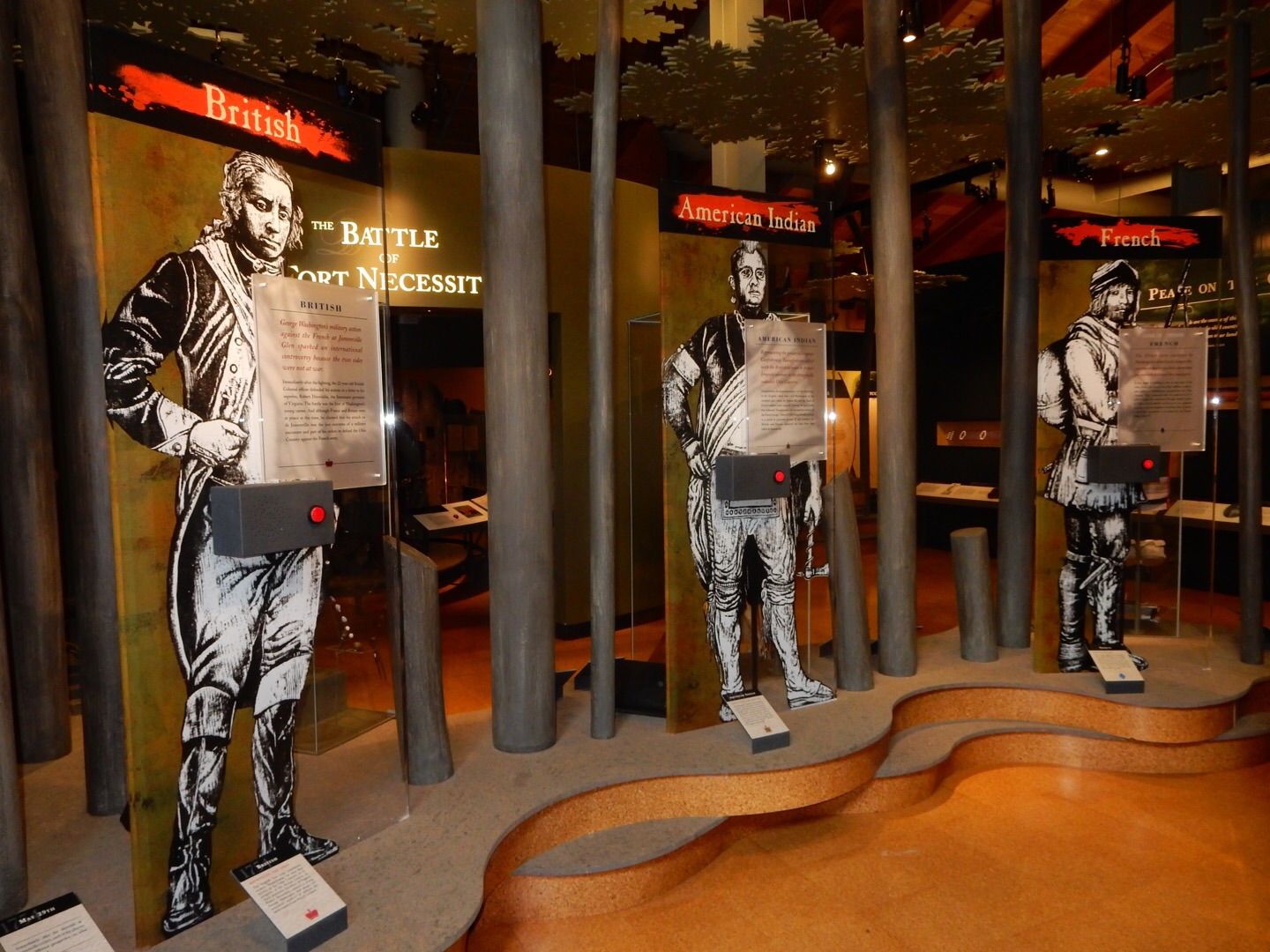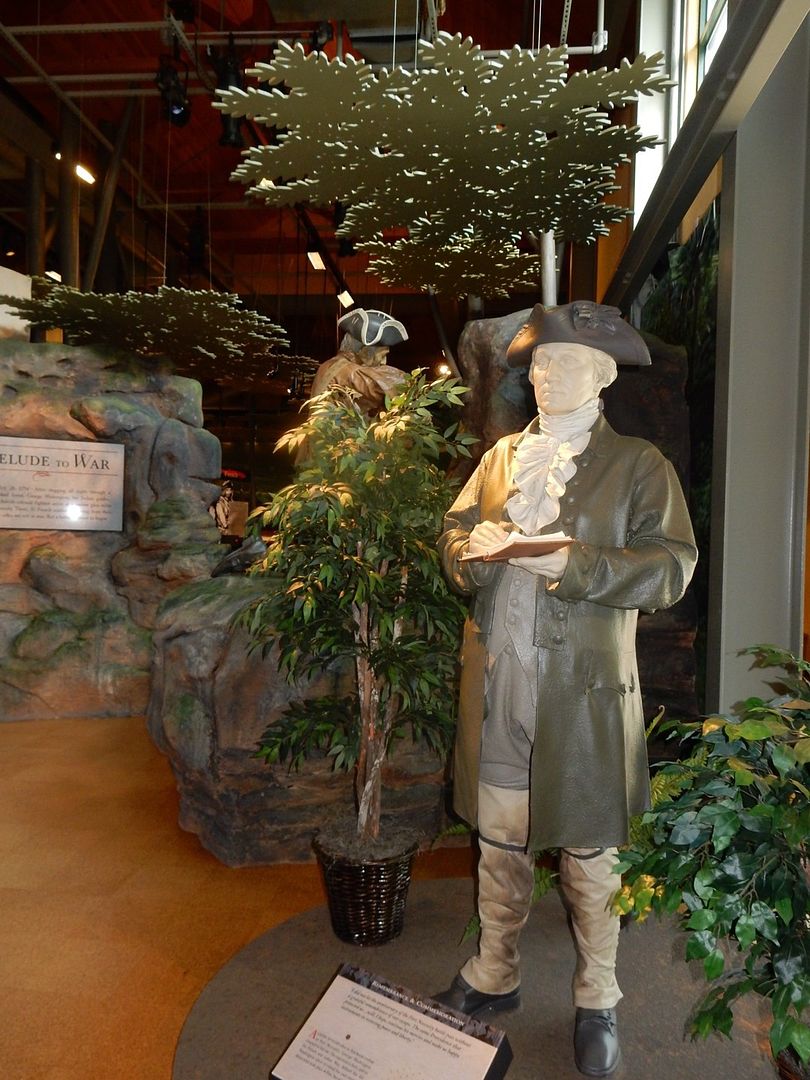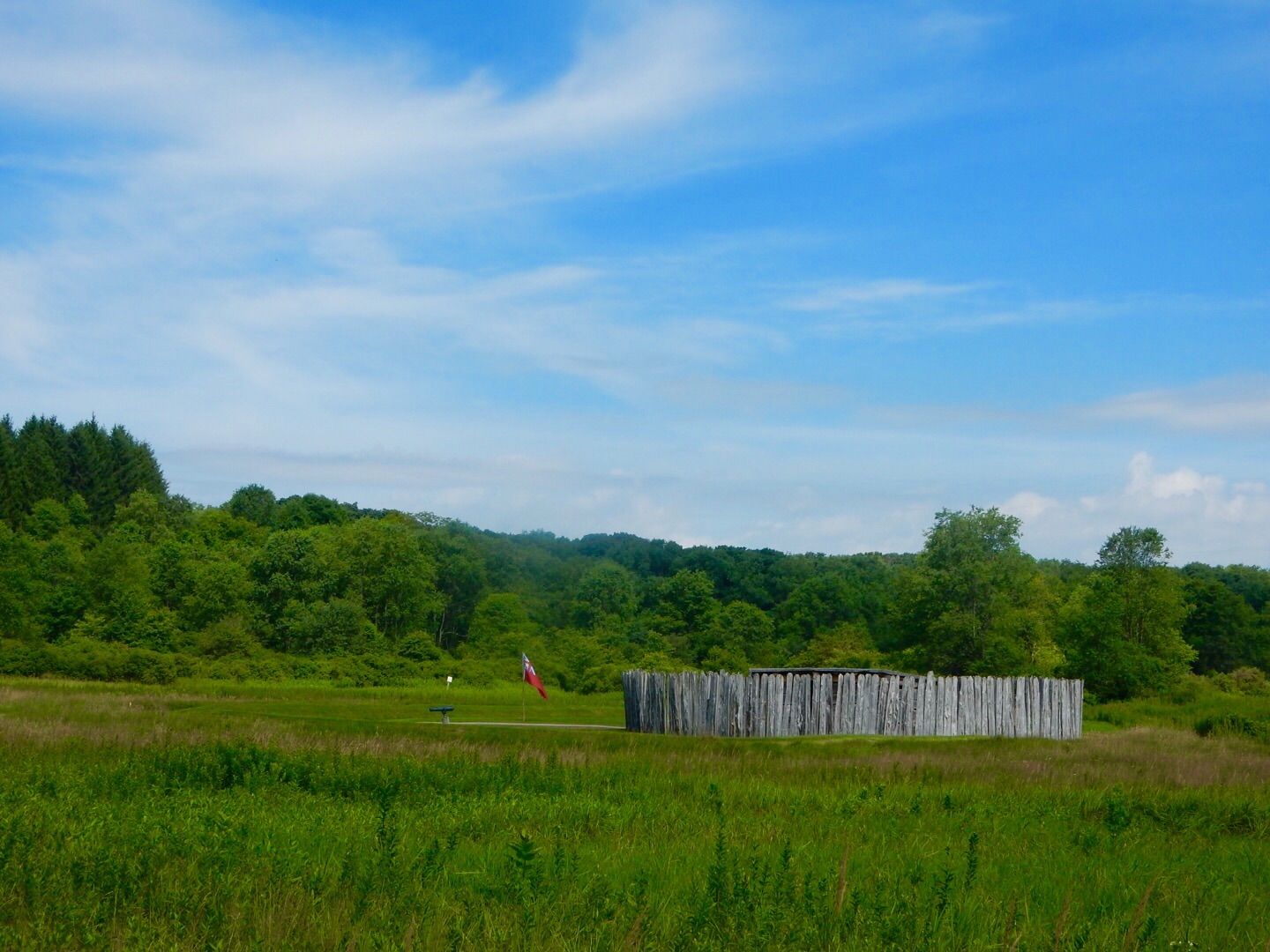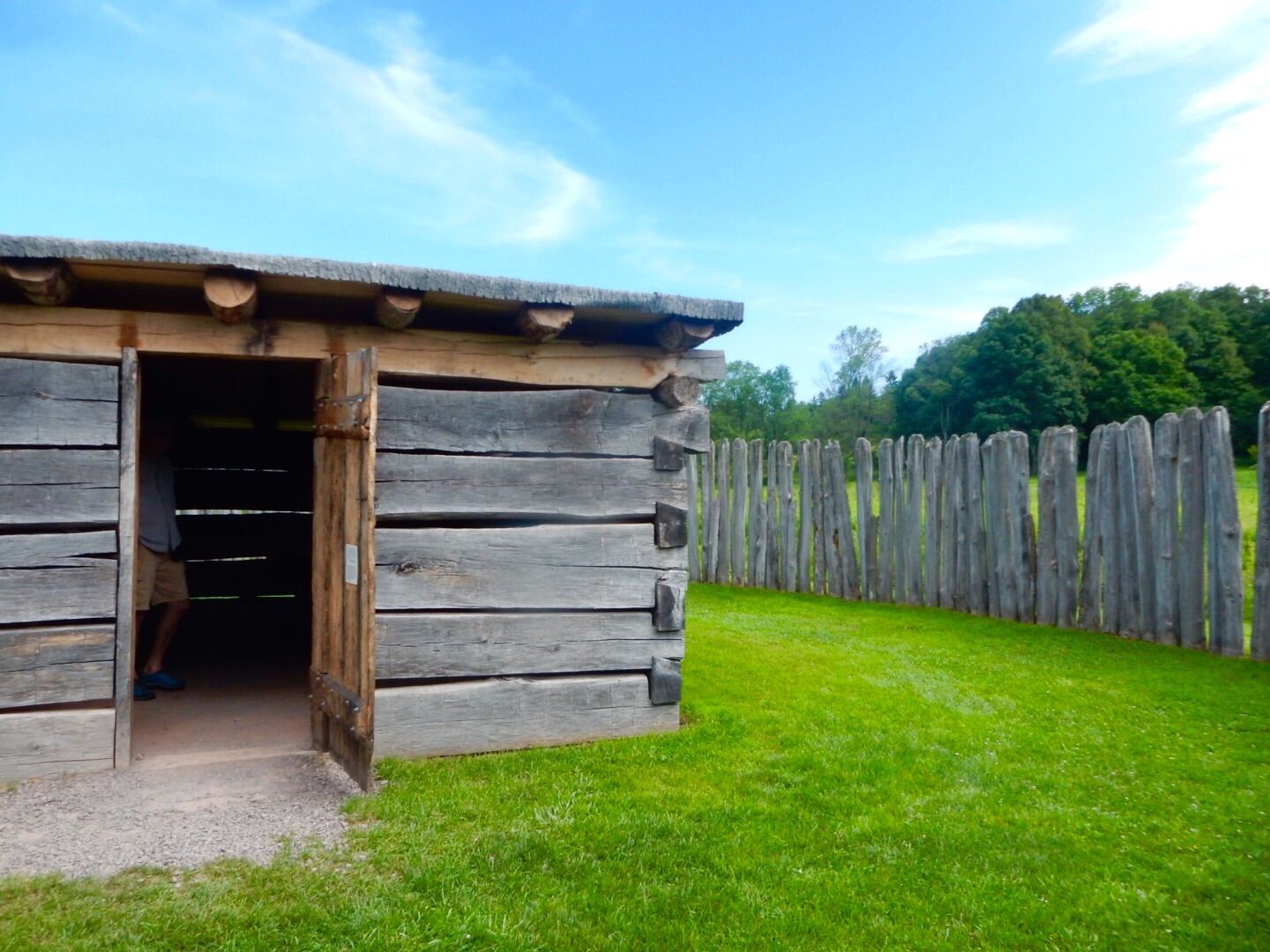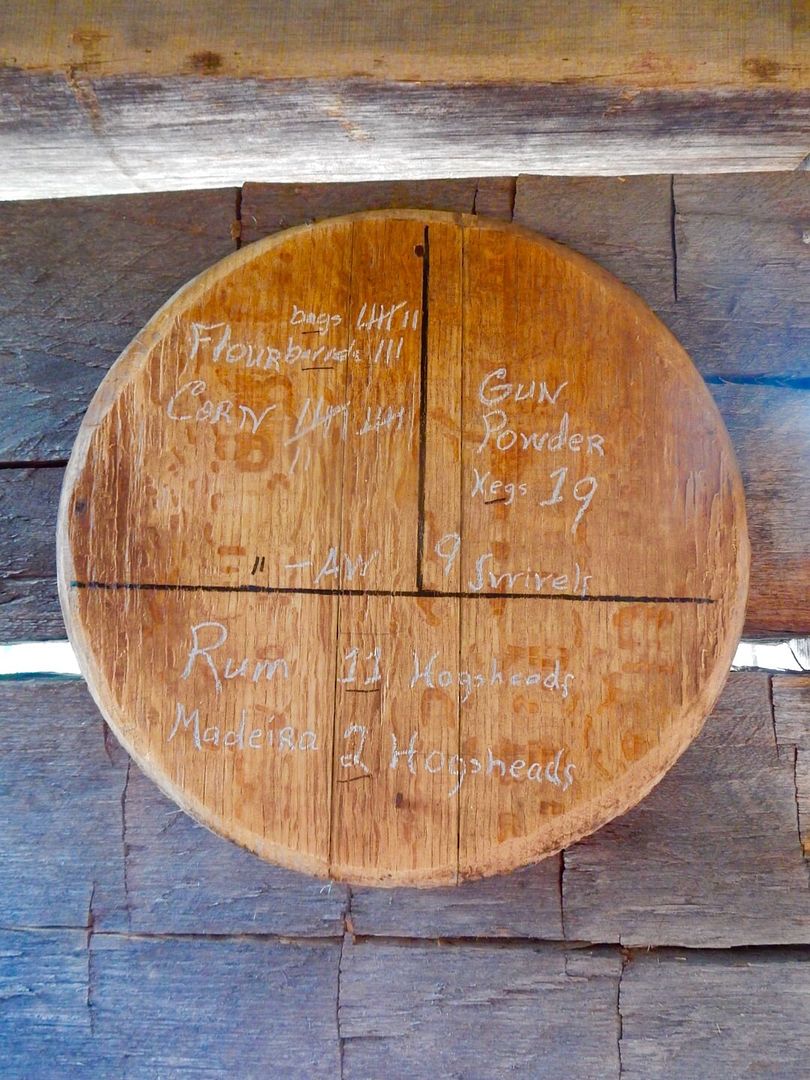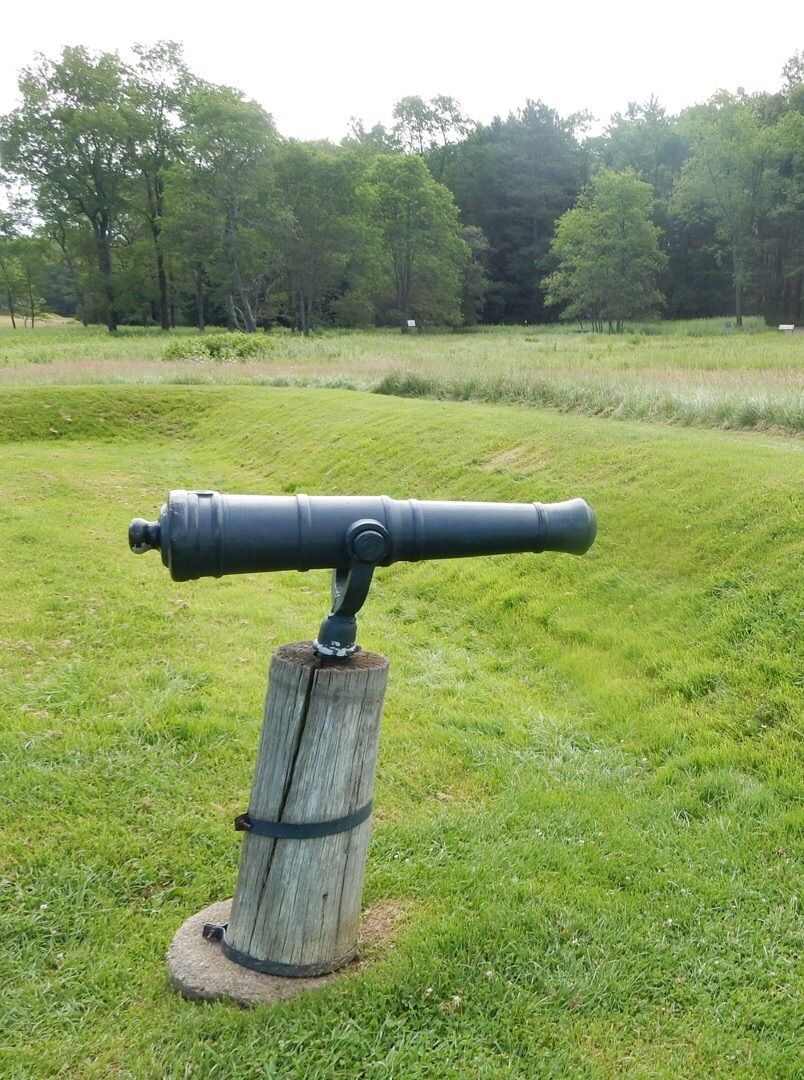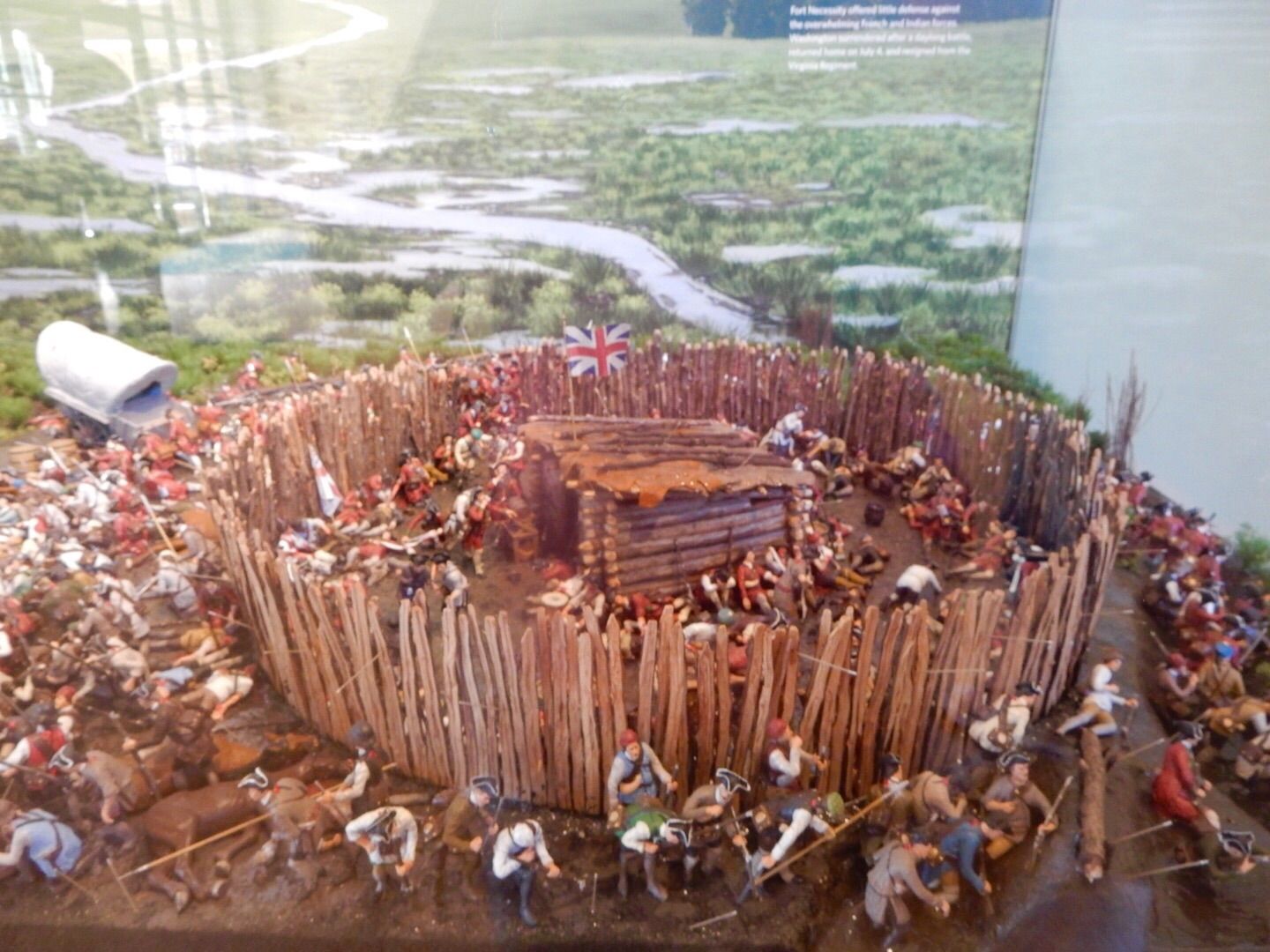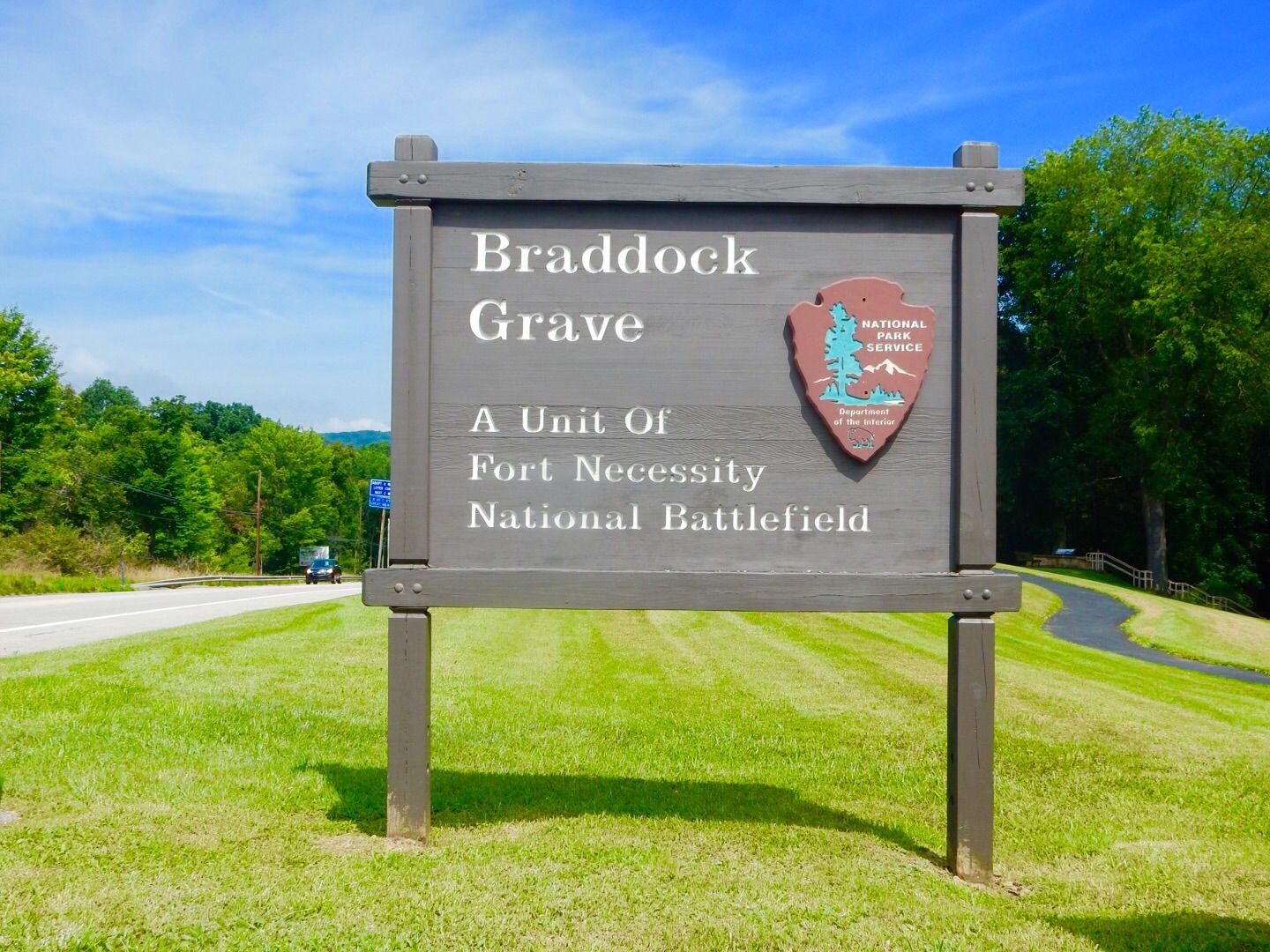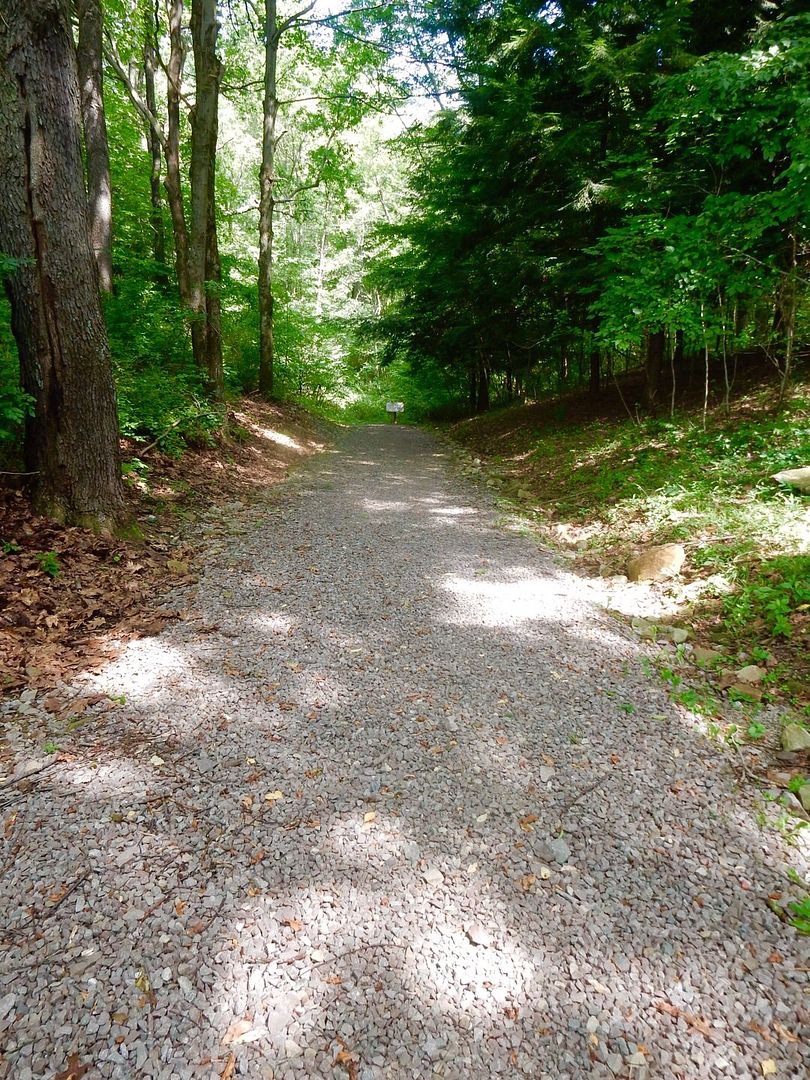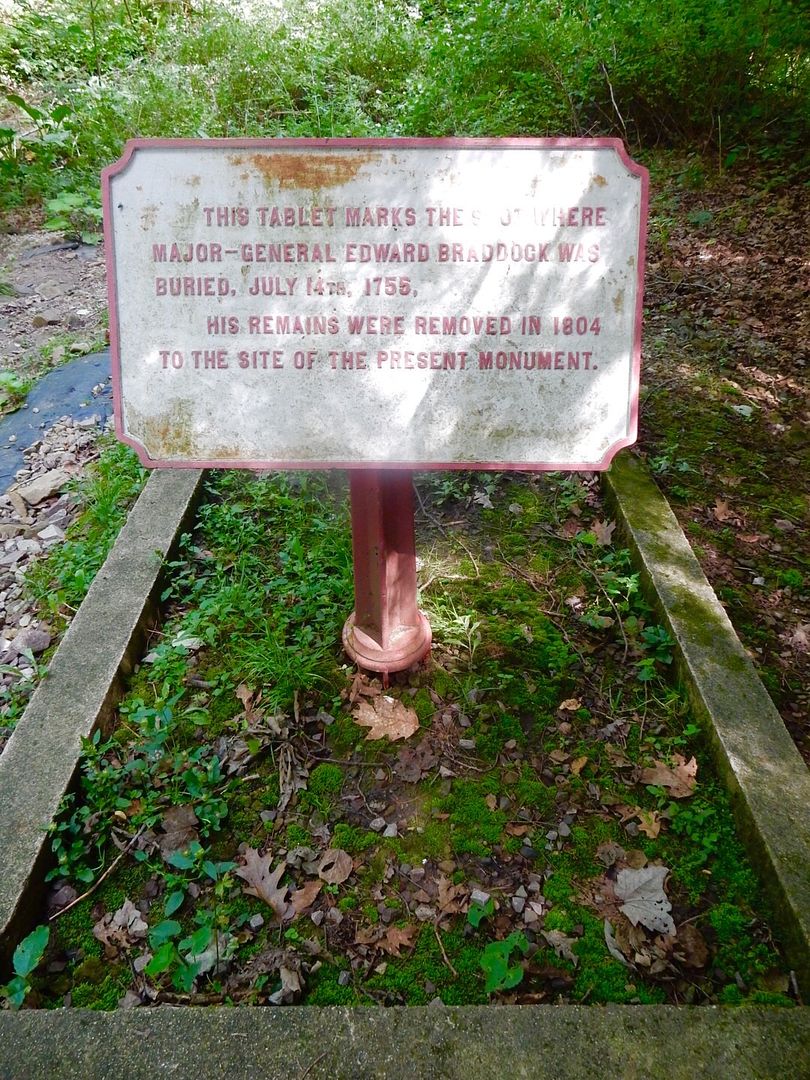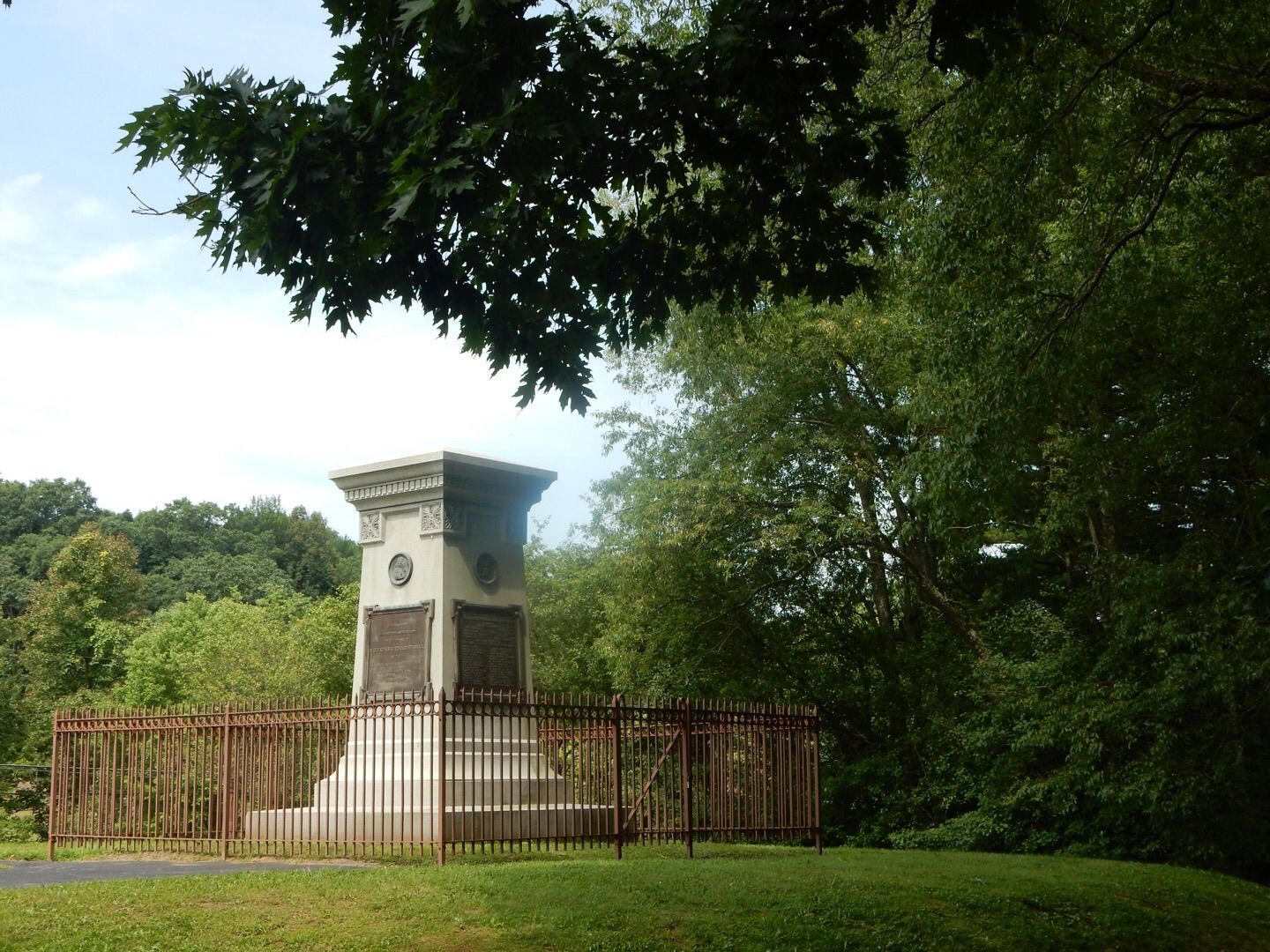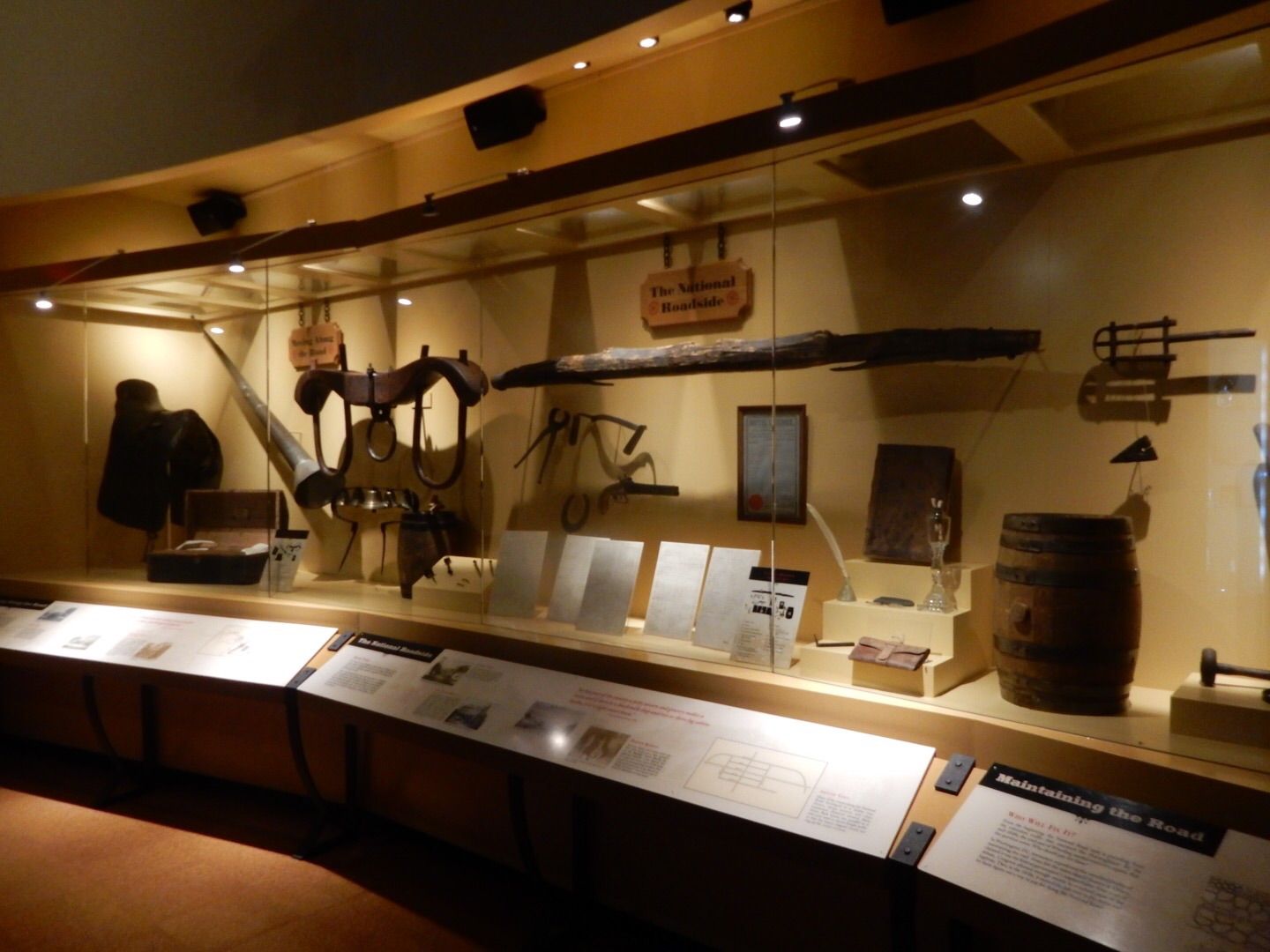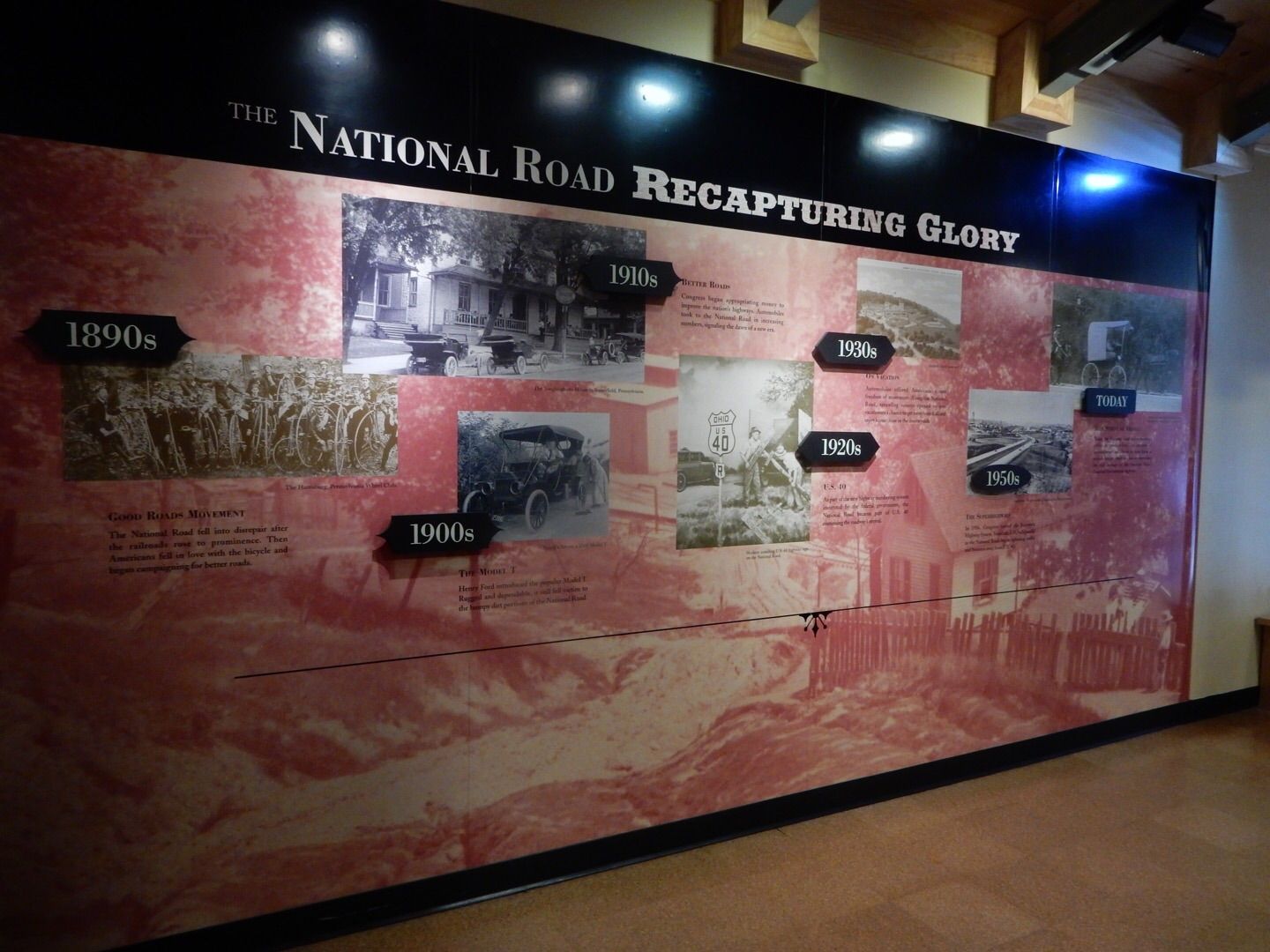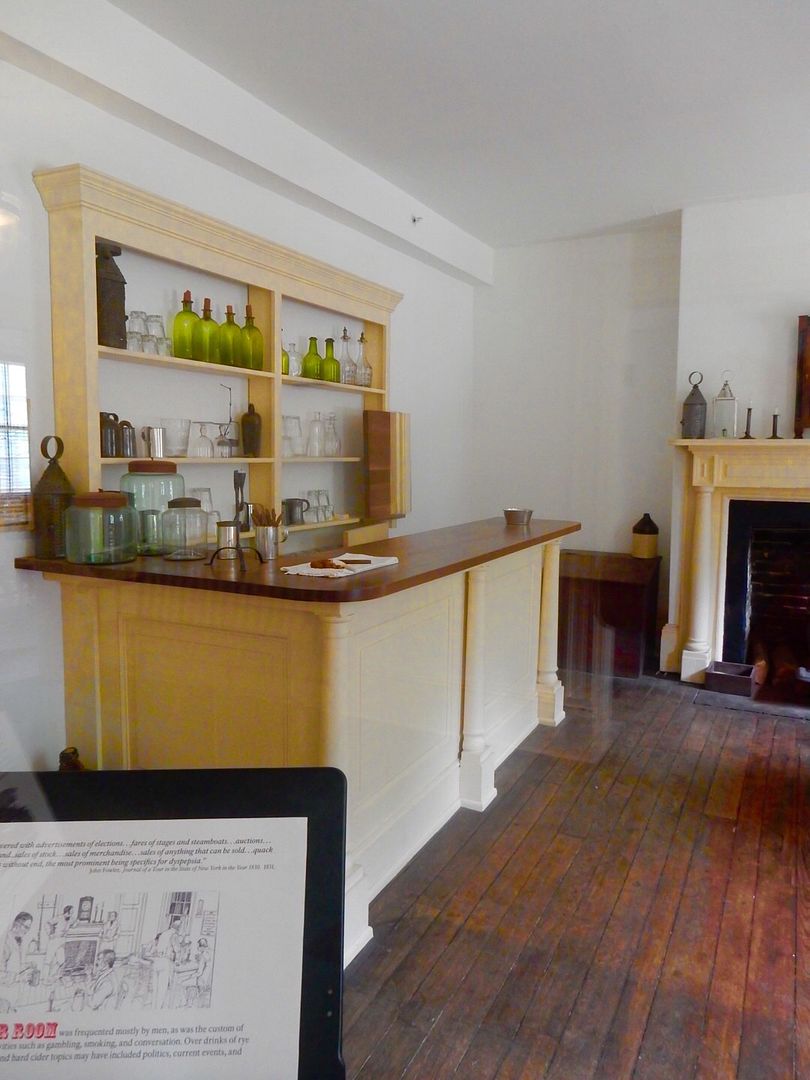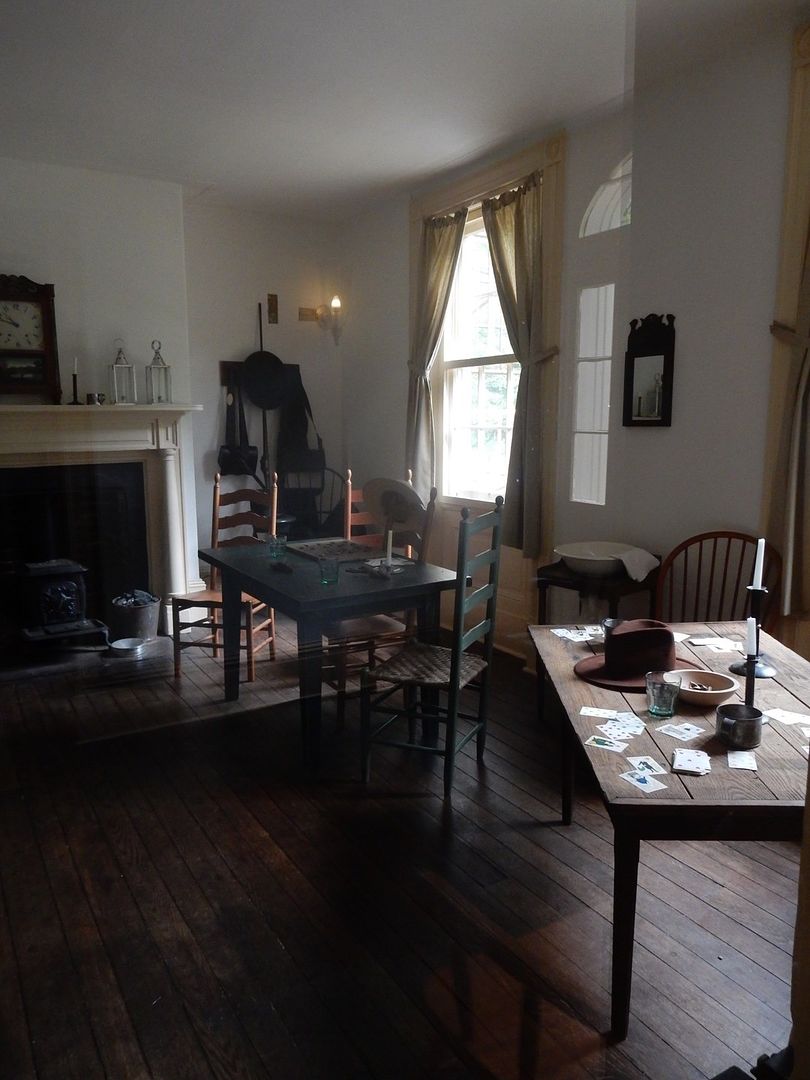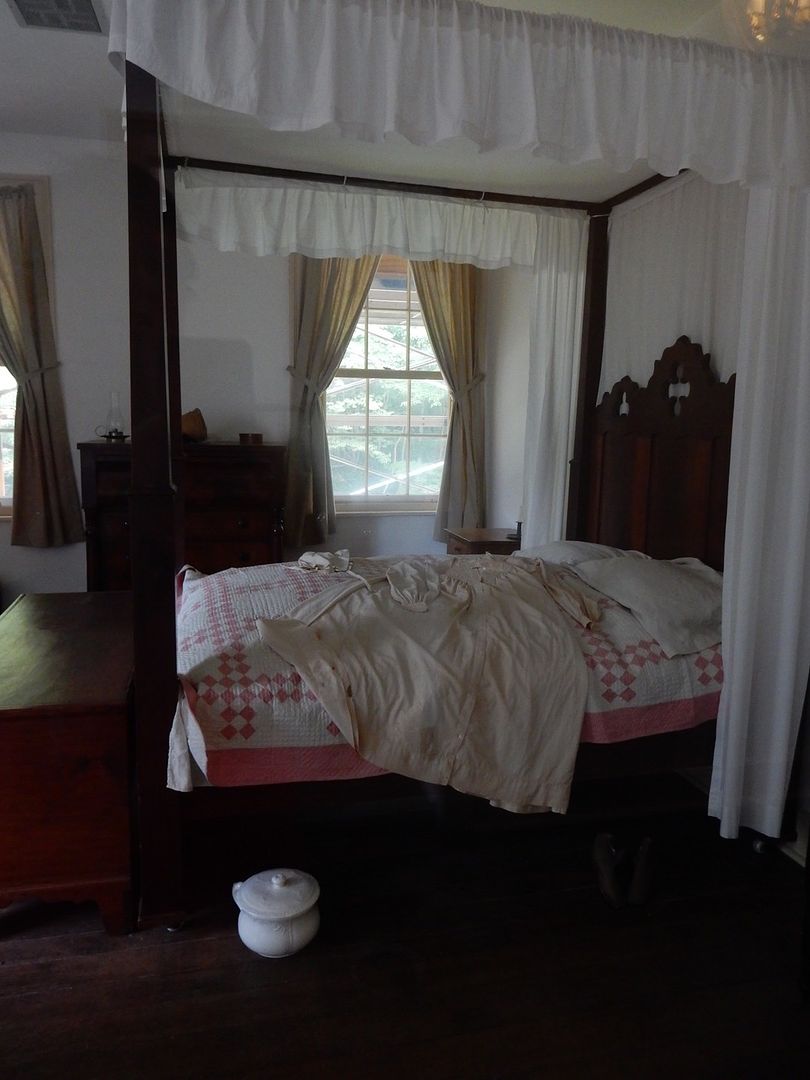Rating: 3.5 on a scale of 5
Location: We selected this park primarily because of two factors: it is approximately halfway from where we stayed in PA for a month and our next one-week visit with family in Columbus, OH; and, it is near Fallingwater (the famous Frank Lloyd Wright-designed home) that I have wanted to see for decades. It was also close to the National Historic Battlefield, Fort Necessity, and the National Historic Site, Friendship Hill (the home of Albert Gallatin). The added bonus is that the park is situated between the banks of the Youghiogheny River and the Great Allegheny Passage Bike Trail. Railroad tracks are located on the other side of the river. At first I wondered what the sound was as they run several times of day and night, but it was not a problem for us. Can you see the train through the trees?
Lot Size: The is a wide variety of lots here; some premium RV back-in sites along the river, deluxe and standard tent sites, many seasonal sites, standard (back-in) RV, and pull-through RV sites.
We had a pull through site that afforded us a view of the beautiful river.
The length was great...even more room than we needed for our motor coach, tow dolly and car. However, it was not very wide. On one side was a seasonal site that was very busy/hectic and we did not appreciate the folks that kept walking through our site! The other side was a pull-through lot that was occupied by various RVers and was vacant a couple of nights during our stay. There are also cabins, that appeared to be very nice, available for rent.
Amenities: Amenities at this park abound! Cable is provided with about 50 channels and the wifi speed was relatively good, especially during weekdays. The laundramat is large and well-equipped with approximately 10 washers and 10 dryers. Trash is picked up at each site in the morning and at night (very convenient). Fire rings and picnic tables are found at each site. There is a large swimming pool, arcade, basketball court, well-equipped playground, K-9 park, and a pavilion where various activities are held during the weekends.
Canoes, kayaks and tubes can be rented for use on the river and include life jackets. There is also a shuttle service that will drop you off three miles upriver. Some folks just launch from the campground and hang out along the river, while others take advantage of the shuttle service. Golf carts and bicycles can also be rented. The office is located in an A-frame building where the standard fare of camping stuff and souvenirs are sold. They also sell ice cream at the that can be enjoyed at outside at tables with umbrellas.
Cost: $236.00
Management: This is a KOA campground and they totally have their act together. Check in was efficient and they were prepared for our arrival. We were escorted to our site which is always convenient. A pass was provided for our car as there are folks at a pavilion upon entry checking for visitors. Overall, the park is well maintained and clean.
General Comments: This is a great campground for families as there are so many fun activities. We had a blast playing air hockey in the arcade room! I didn't rate it higher because of the large number of seasonal (permanent) sites. This always seems to create a weird vibe for us full timers (may just be my imagination!) Regardless, this would be a great place for a family with children to spend a week or more on a summer vacation. There is so much to do! Overall, we were happy with our stay.
Website: www.uniontownkoa.com
Friday, July 31, 2015
Wednesday, July 22, 2015
Fallingwater - 7/20/15
Fallingwater is a house built over a 30-foot waterfall on Bear Run in western Pennsylvania.
It was designed for Liliane and Edgar Kaufmann, owners of an upscale Pittsburgh department store, as a mountain retreat by the famous architect, Frank Lloyd Wright. Built between 1936-1939, it quickly became famous for the sublime integration of building and nature. It appeared on the cover of Time Magazine in 1939 and is now a National Historic Landmark preserved by the Western Pennsylvania Conservancy.
The textiles selected for Fallingwater were a key design element to the interior and were very carefully chosen.
There is a beautifully-designed Visitor Center where we checked in and were assigned our tour number. A gift shop, gallery, cafe, and restrooms can be found here while you wait for your tour to be called. The lovely gift shop has many exquisite Wright-themed items for sale as well as other souvenirs.
There is also a Gallery that provides insight into the Kaufmanns and some of the interior furniture and decorative selections. Below is a lounge chair designed by Bruno Mathsson in 1936. Five of his chair designs can be found in Fallingwater.
The planetarium was used as an educational tool. One is displayed in the living room of the house.
The textiles selected for Fallingwater were a key design element to the interior and were very carefully chosen.
Because photos are not permitted inside Fallingwater, exhibits in the gallery display photos of some of the rooms.
Tours begin on this beautiful wooden boardwalk to the road to the house (about a .25 mile walk).
The first view of the house does not disappoint! Our first stop on the tour was on the bridge over Bear Run.
Below is a bronze sculpture, Mother and Child, by Jacques Lipchitz, next to the splash pool.
Bear Run could be accessed directly from the house by the steps seen here. Sometimes after heavy rains, Bear Run rises to the 5th step! Only once has there been a flood (in the 1950s) that reached the level of the first cantilevered floor.
Below is a bronze sculpture, Mother and Child, by Jacques Lipchitz, next to the splash pool.
Bear Run could be accessed directly from the house by the steps seen here. Sometimes after heavy rains, Bear Run rises to the 5th step! Only once has there been a flood (in the 1950s) that reached the level of the first cantilevered floor.
Some facts of interest:
- Cost: $155,000 including $8,000 for the architect (Wright). Today it would be valued at approximately $2.5M. The Kaufmann's had originally planned to spend only $35,000.
- Square footage: Main House = 5,330; interior is 2,885 and terraces 2,445. The Guest House is another 1,700 square feet.
- Color palette: Light ochre for the concrete; Wright's signature Cherokee Red for the steel.
- Ownership: The Kaufmanns lived in the house (part-time) until their deaths in the 1950s. Their son, Edgar, Jr., continued to live here until 1963 when he donated the house and 1,700 surrounding acres to the Western Pennsylvania Conservancy. The Conservancy manages the property and maintains the house.
After touring the main house and guest house, we walked along the path to the fabulous views seen below.
On the way back to the Visitor Center, we stopped briefly for some additional photos of beautiful Bear Run.
Be sure to purchase tickets on-line for the date and time you want to visit. We were surprised at how many visitors were there when we visited on a Monday morning. Tickets are $25/adult when purchased in advance ($27 if purchased on-site) for a guided house tour (each group is comprised of 12 people). This is the only way to see the interior of the house and children under 5 are not permitted on house tours.
I have heard of this house for decades and was thrilled to finally see it in person. It is as beautiful as I imagined it would be. How the creek and rock formations are integrated into the design of the house is truly amazing. Go out of your way to see this place! It is so worth it. The pictures just do not do it justice.
Tuesday, July 21, 2015
Friendship Hill National Historic Site, 7/19/15
Friendship Hill was the home of Swiss-born, Abraham Alfonse Albert Gallatin. He is described as an entrepreneur, politician, diplomat, financier, gentlemen, farmer, and scholar and played an important role in shaping US politics and culture.
Sadly, Sophia died several months later and Gallatin entered politics that same year after her death.
Born in 1761, he came to America when he was 19 and became a US citizen in 1785. The following year he bought this 370-acre farm in Fayette County in southwestern PA. He married Sophia Allegre in 1789 and started building the two-story brick house that he named Friendship Hill.
Sadly, Sophia died several months later and Gallatin entered politics that same year after her death.
Gallatin married Hannah Nicholson of New York City, daughter of former US Navy commander-in-chief, James Nicholson, in 1793. In 1798, he added the two-story, two-room, Frame House to accommodate his growing family. He and Hannah had six children; three died in infancy.
The room was the bedroom and schoolroom for James and Albert Rolaz, the two sons of Albert and Hannah.
The room was the bedroom and schoolroom for James and Albert Rolaz, the two sons of Albert and Hannah.
Gallatin's public service took the family to Philadelphia, Washington, DC, Paris, and London. While in Paris, he directed his son, to supervise a large addition, the Stone House to Friendship Hill. The addition was completed in 1823 followed by the stone kitchen the following year.
Portrait of Gallatin and front parlor are shown below.
Stone Kitchen completed in 1824.
Hannah never enjoyed the frontier life and Albert put Friendship Hill up for sale in 1825 when the family moved to New York City. Subsequent owners enlarged and altered the house over the years. Visitors to this National Historic Site are provided with a floor plan that shows these various changes that is used during the self-guided tour of the house.
If you are wondering why the home of Albert Gallatin has been designated a National Historic Site, here are some of the significant accomplishments and contributions he made to the US.
- 1789, enters political life as a delegate to the Pennsylvania convention and helps draft the state constitution.
- 1793, US Senator.
- 1795, founds New Geneva, PA, establishing New Geneva Glassworks and a fun factor several years later bringing industry to the region.
- 1801, US Secretary of the Treasury, for next 13 years for Presidents Thomas Jefferson and James Madision. When he entered office the country had debt of $85M; he figured out how to fund the LA Purchase (1803), the Lewis and Clark Expedition (1804), and the War of 1812. His long-term financial plan was used by subsequent Treasurer Secretaries and the national debt was paid off in 1835.
- 1814, signer of Treaty of Ghent
- 1816, US Minister to France for 7 years.
- 1826, US Minister to Great Britain for 2 years.
- 1831, President of National Bank of New York for next 8 years (that is JP Morgan-Chase today).
- 1842, President of New York Historical Society; and founds American Ethnological Society. Both are still in operation today.
- 1849, died in Long Island, New York at age 88.
Very impressive legacy! I really enjoyed learning more about this important American.
Admission to this site is free. It is located about 30 minutes from Fort Necessity so we visited both the same day. Be sure to check out the Visitor Center as we found the Park Rangers to be very informative. It is also serves as the entrance to the self-guided tour of the houses/s.
There are trails on the property, but it was so very hot and humid the day we visited that we did not explore them.
Website: www.nps.gov/frhi
Fort Necessity National Battlefield, 7/19/15
Located about 10 miles west of Uniontown, PA, is the where the opening battle of the war fought by England and France for control of North America occurred in 1754. There were rival claims between the two countries for the territory between the Appalachian Mountains and the Mississippi River (the Ohio Valley). The conflict came to be known as the French and Indian War here and as the Seven Years' War in the rest of the world (1754 to 1763). At the end of the war, France was expelled from North America and India.
90% of the structure is original and restoration work is currently underway on the exterior. The interior remains open.
Travelers had a hot meal in the dining room. Women gathered in the parlor after dinner while the men went to the barroom.
Men and women slept in separate rooms on the second floor, often sharing bedspace with strangers. Most just slept in their clothes arising early the next morning to continue their journey.
Our first stop here, as always, was the Visitor Center.
There are impressive exhibits as well as a video that can be seen in the theatre that provide the history of Fort Necessity, Braddock's Grave, The National Road, and Mount Washington Tavern. The Park Rangers shared with us the schedule for the day for Ranger-led tours, educational sessions, musket firing, etc.
Fort Necessity:
Fort Necessity:
George Washington, a 21-years old lieutenant colonel for the British, was sent to warn the French to withdraw from the area in 1753-54.
They refused, setting the stage for the battle at Fort Necessity. The Native Americans informed Washington that a French scouting party was in nearby Jumonville Glen. The Virginia Regiment led by Washington engaged in a squirmish that resulted in the French commander being killed. Debate continues on how the battle began: the French contend they were ambushed and murdered; the British said that the French fired the first volley.
When Washington and his troops arrived at the Great Meadows they were exhausted and with only limited supplies. They began building a stockade structure with an enclosed shed to house supplies (flour, corn, gunpowder, musket balls, cannon shot, and rum). He also had them dig trenches around the stockade area that can be seen today.
The French attacked at dawn on July 3, 1754 with a force of 700. Washington's 300 men were outmanned and were poorly position for the battle. In torrential rain the fight lasted about 8 hours resulting in 30 dead and 70 wounded of the 300 British troops. The French offered terms of surrender that Washington accepted and his troops retreated in defeat.
The British turned the tide of the war in 1758. It ended in America in 1760 when the British captured Montreal. The Seven Years War continued in other parts of the world until 1763.
Braddock Grave: The Braddock Road opened in 1751 between Fort Cumberland (upper Potomac in VA) to the French military station at Fort Duquesne (Pittsburgh). It was named for British General Edward Braddock who, accompanied by Colonel George Washington of the Virginia Militia, used it for the failed assault on Fort Duquesne in 1755.
Injured in the fighting at the Battle of Monongahela, Braddock died of his wounds 7/14/1755 and was buried in the middle of the road by his men. They feared that the Native Americans would mutilate his body if they found the secret grave.
In 1804, during repairs to the road, workmen uncovered Braddock's grave. His remains were disinterred on this hill. The granite monument was added in 1913.
The National Road: George Washington proposed a route to connect the Western frontier to the eastern seaboard in the late 1700s. The building of the road, later named The National Road, was authorized by Congress in 1806. Work began in 1811 and connected Cumberland to Wheeling by 1818. By 1829, the road stretched 600 miles to Vandalia, IL. It was the first federally funded highway. A few original markers can be seen today along Route 40 which follows most of the original route.
Mount Washington Tavern: Built in 1830, Mount Washington Tavern was stage stop for the Good Intent Stage Line. It was one of many such establishments along the National Road, although this was finer than most.
90% of the structure is original and restoration work is currently underway on the exterior. The interior remains open.
Travelers had a hot meal in the dining room. Women gathered in the parlor after dinner while the men went to the barroom.
Men and women slept in separate rooms on the second floor, often sharing bedspace with strangers. Most just slept in their clothes arising early the next morning to continue their journey.
Admission to Fort Necessity is $15, but our senior pass gets us in for free. Honestly, I had never heard of this place. We thoroughly enjoyed the quality exhibits at the Visitor Center and learning more about our nation's history in this part of the country. If you visit, be sure to tour the Tavern and Braddock's grave that are located a distance from Fort Necessity. You can walk or drive to the Tavern, but will need to drive a couple of miles to the grave.
Website: www.nps.gov.fone
Subscribe to:
Posts (Atom)
